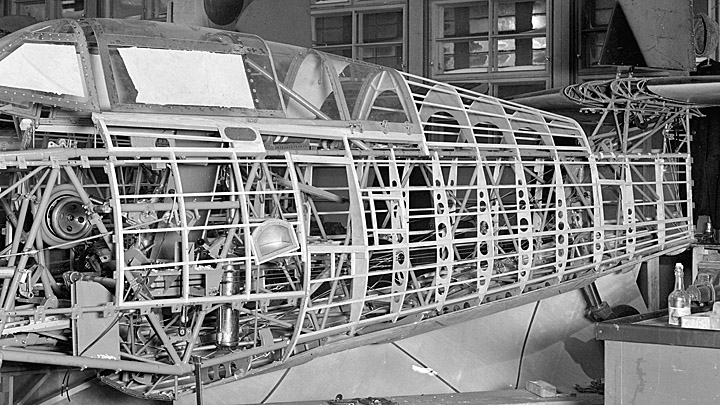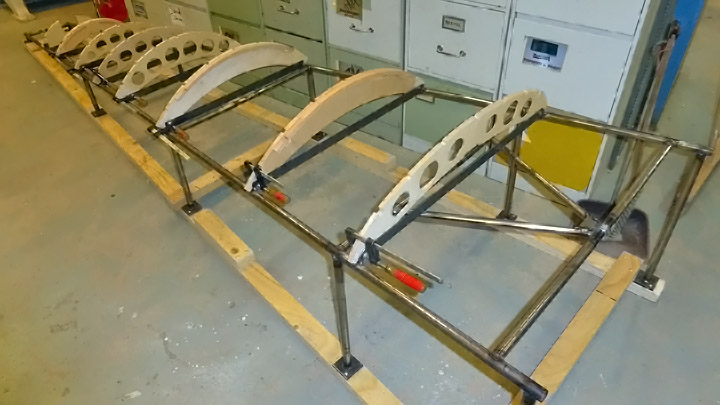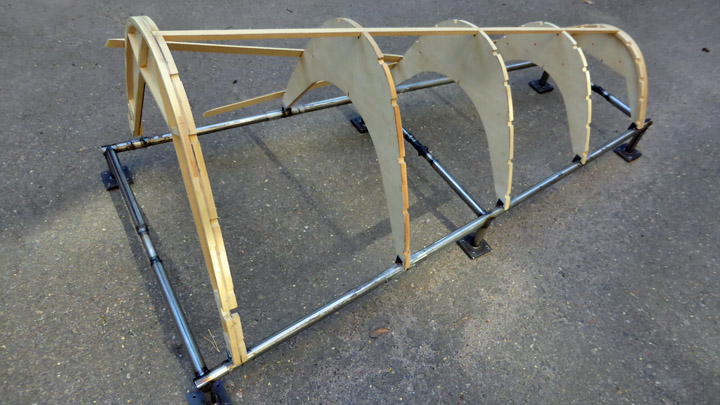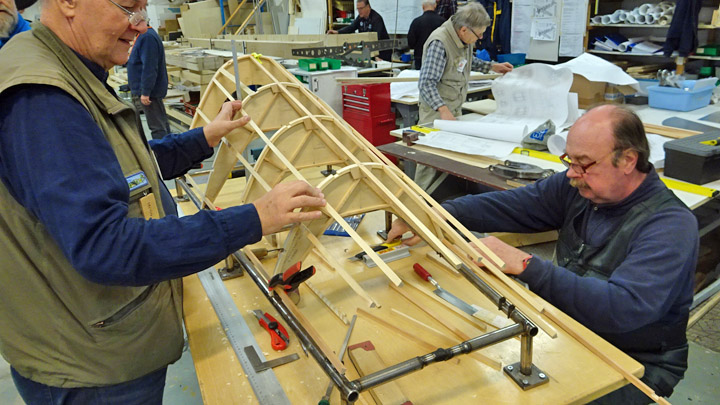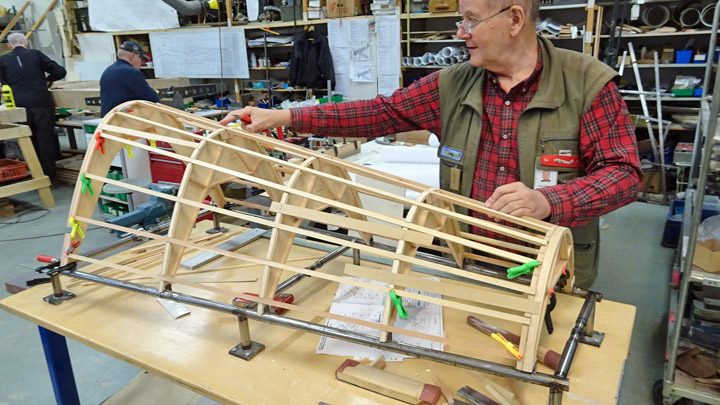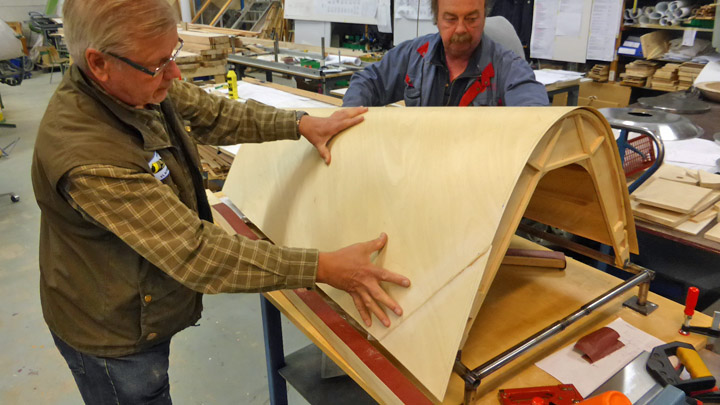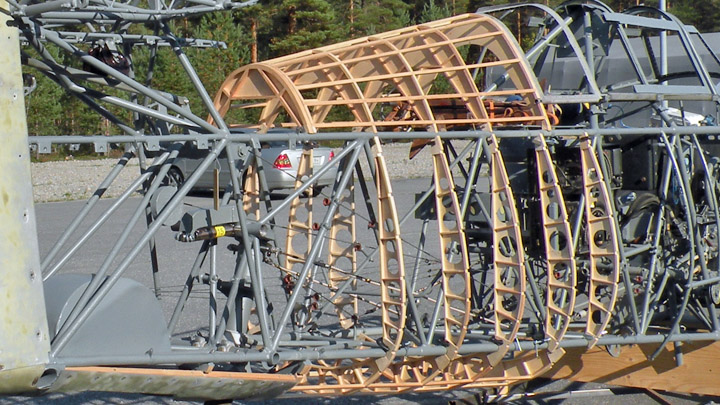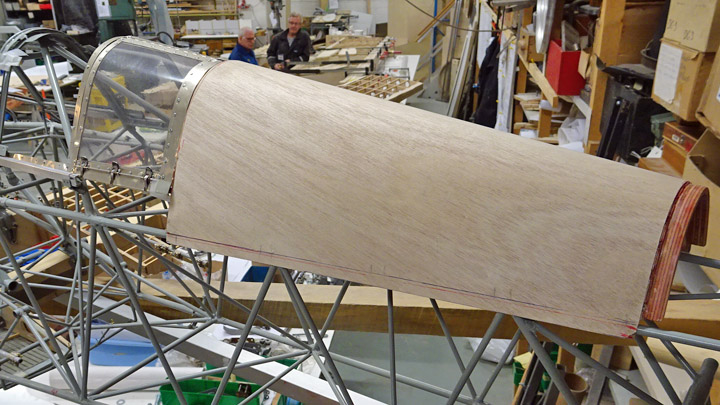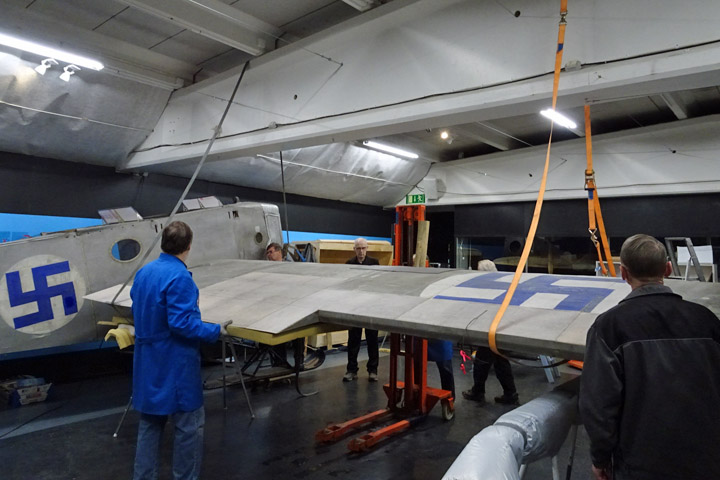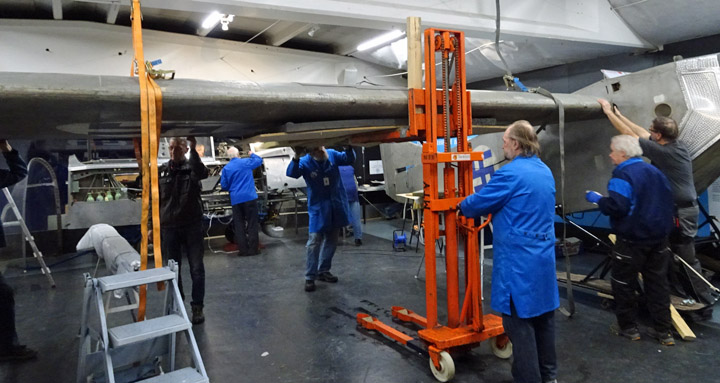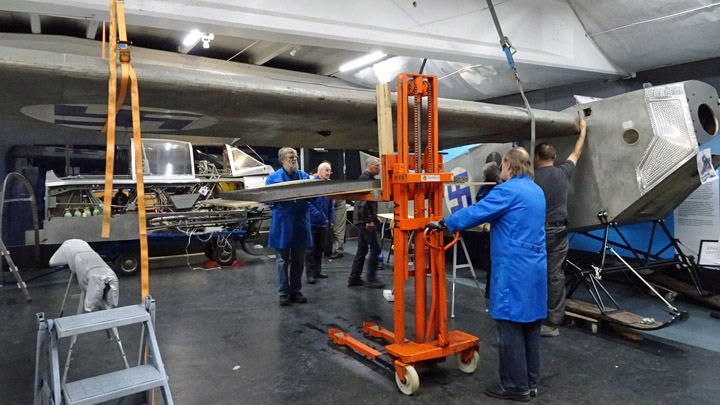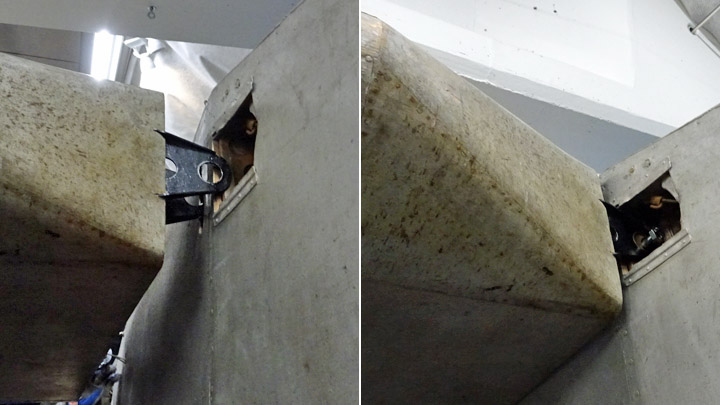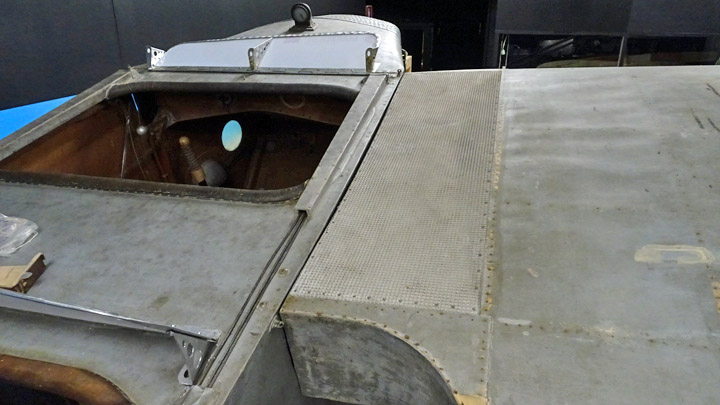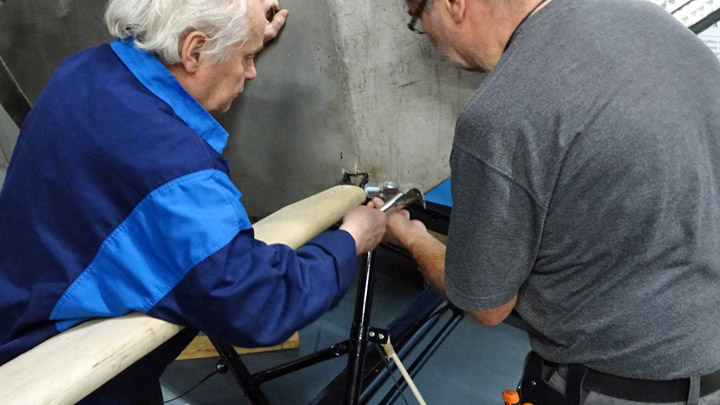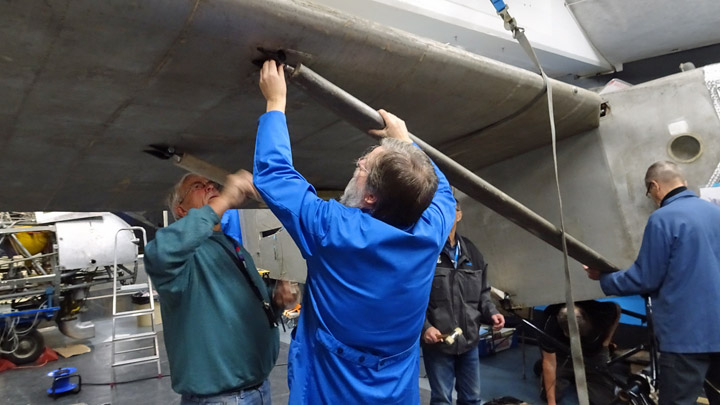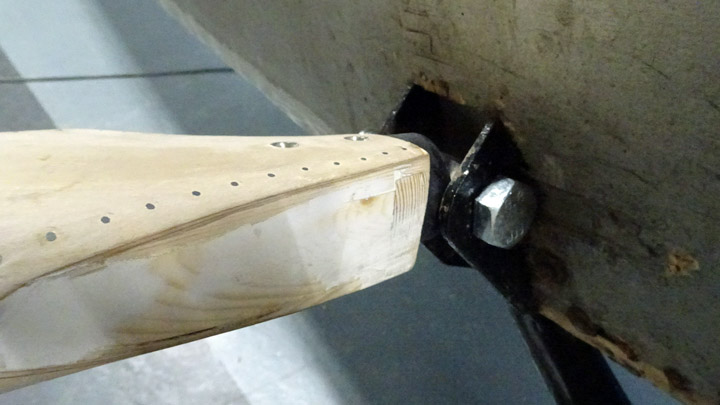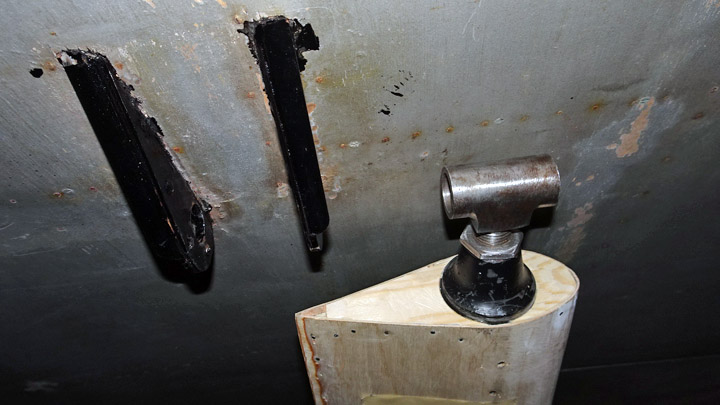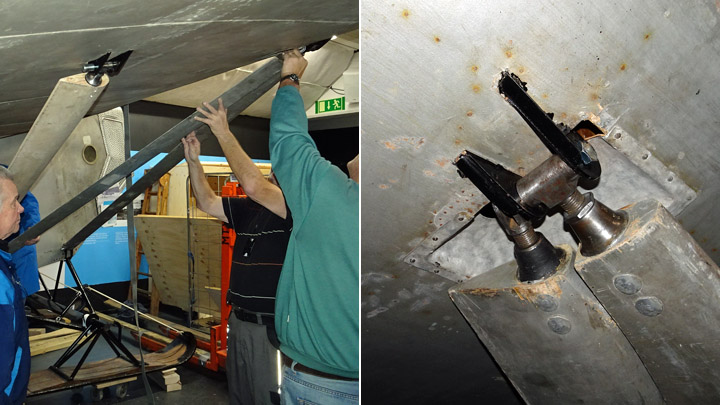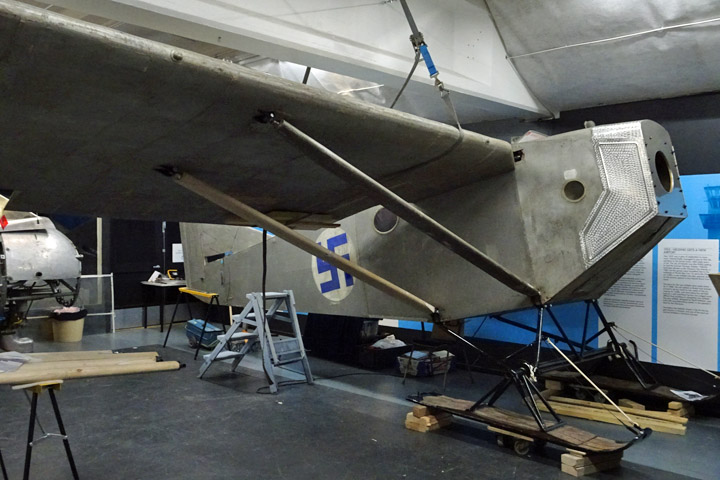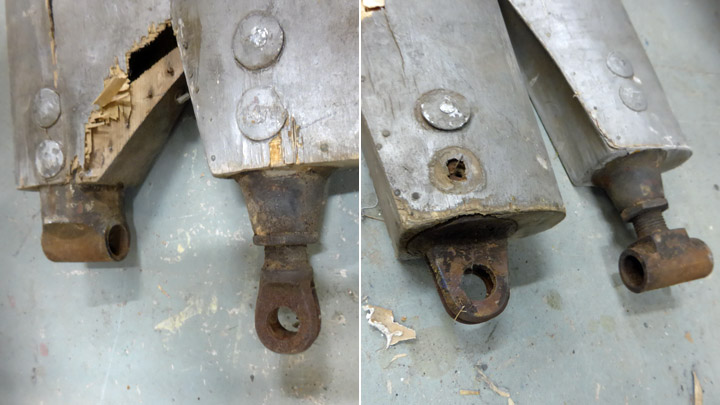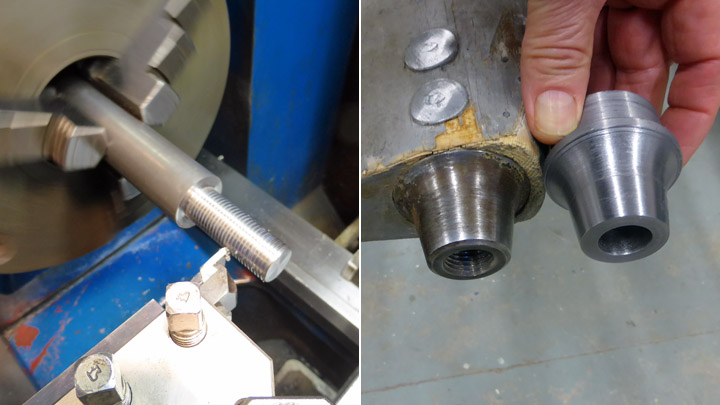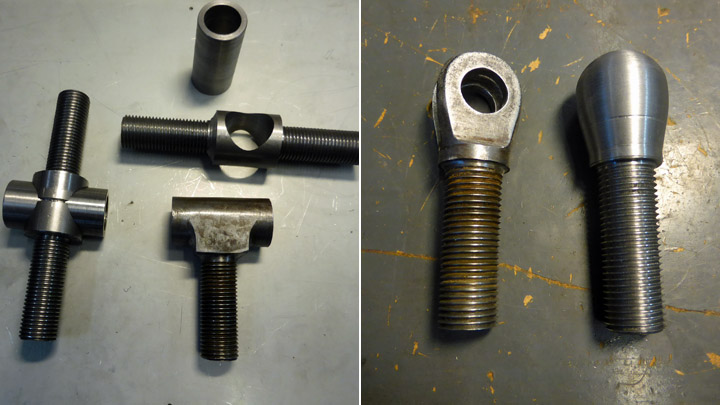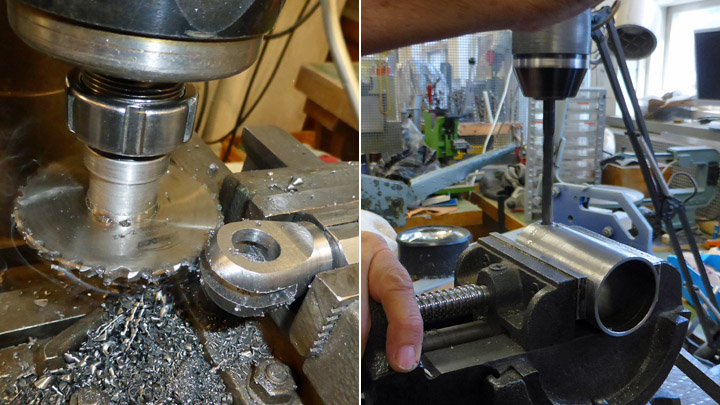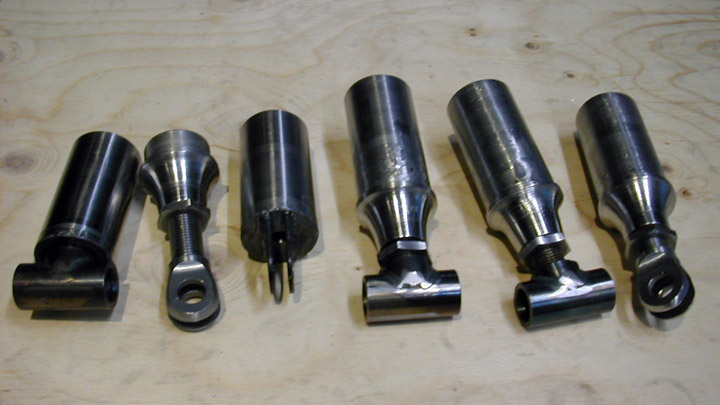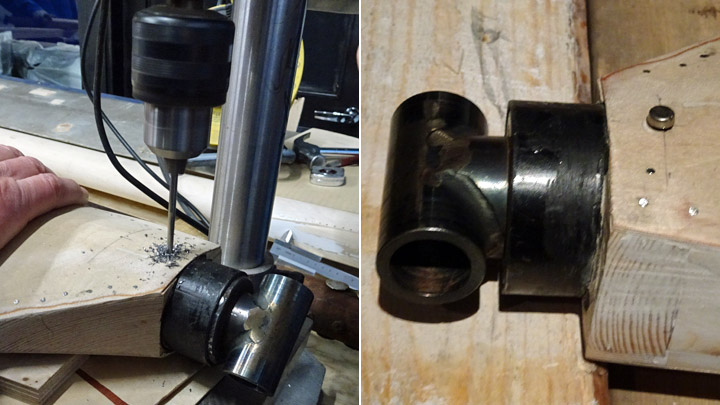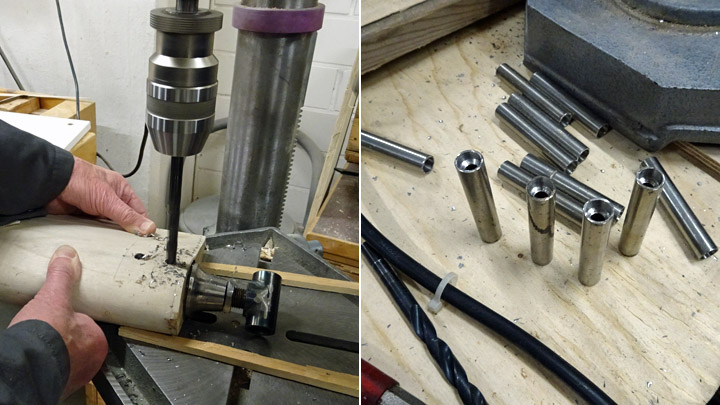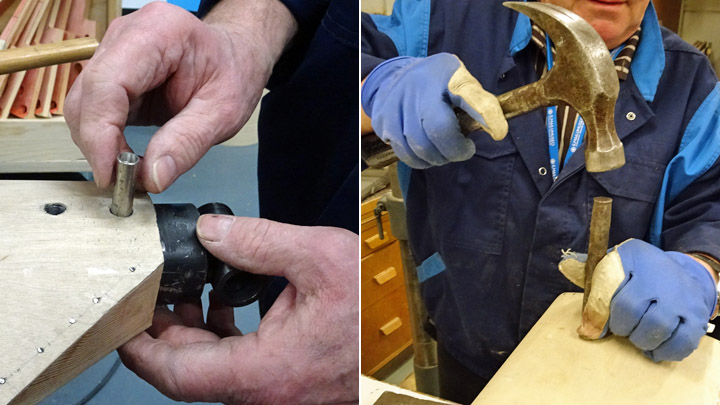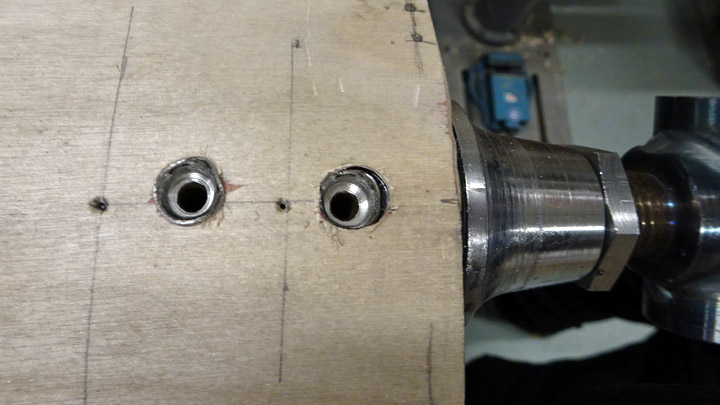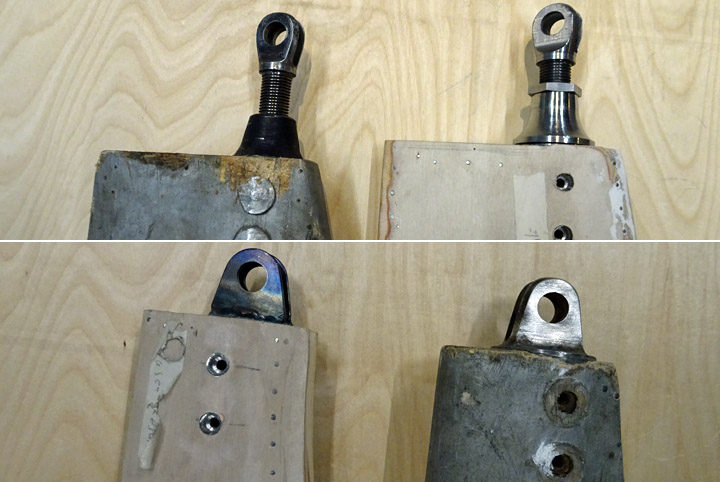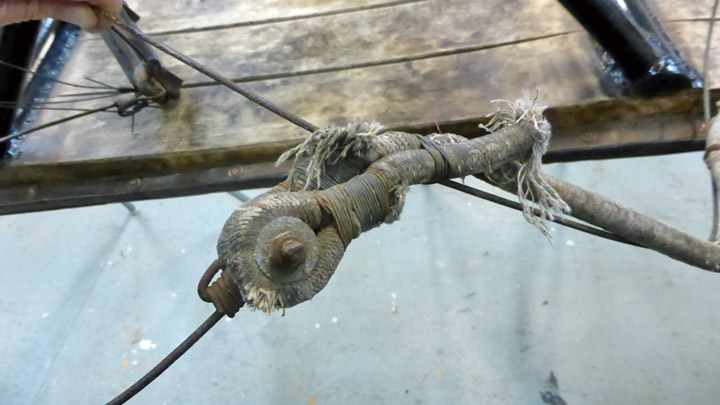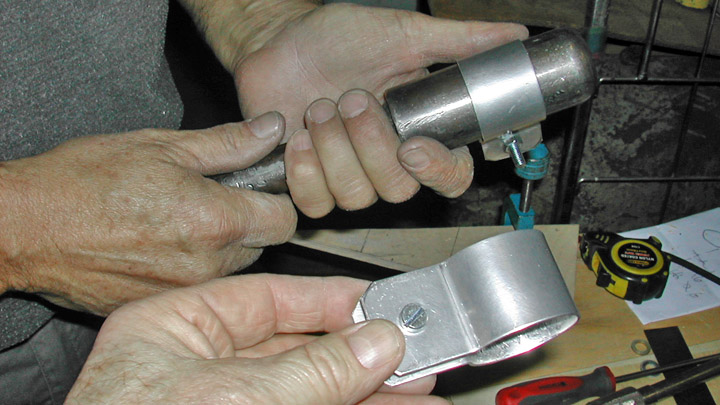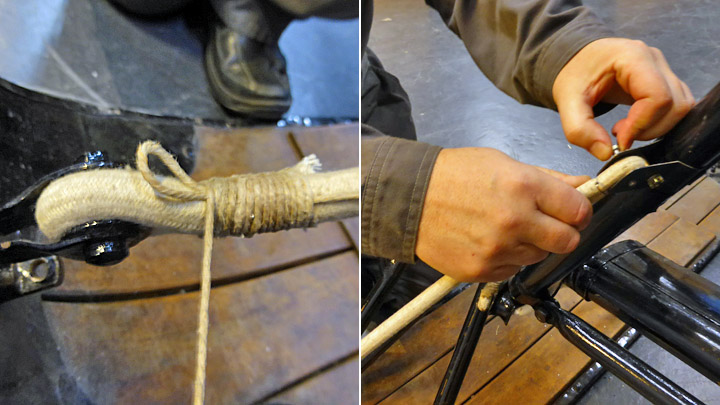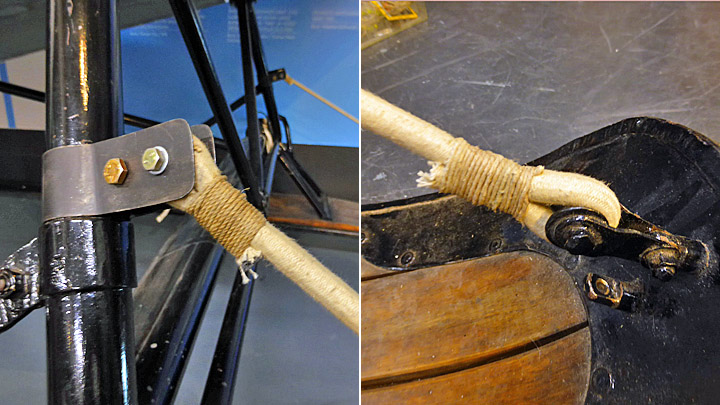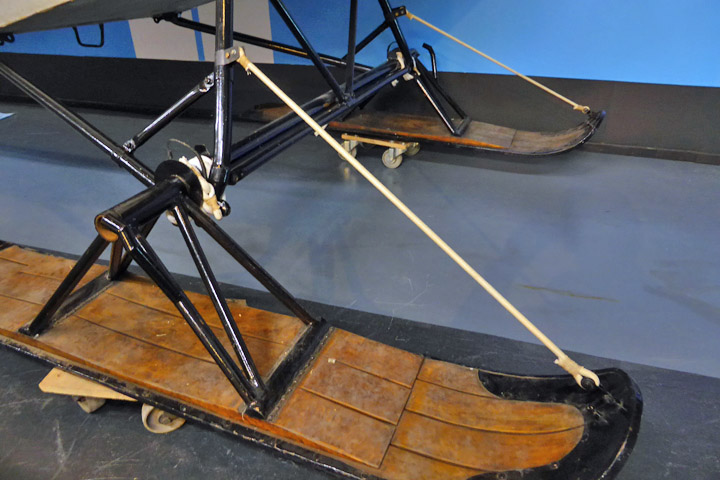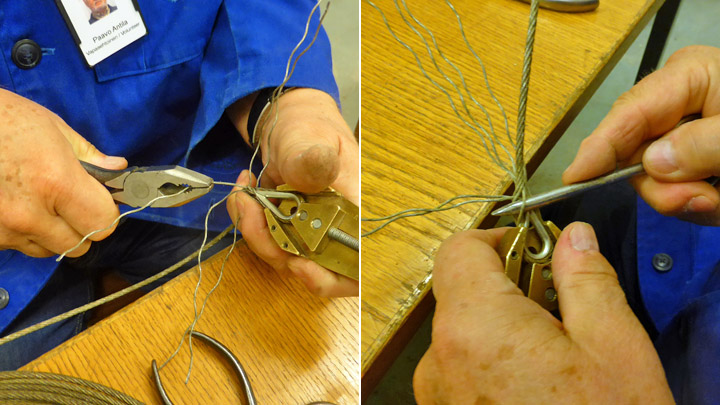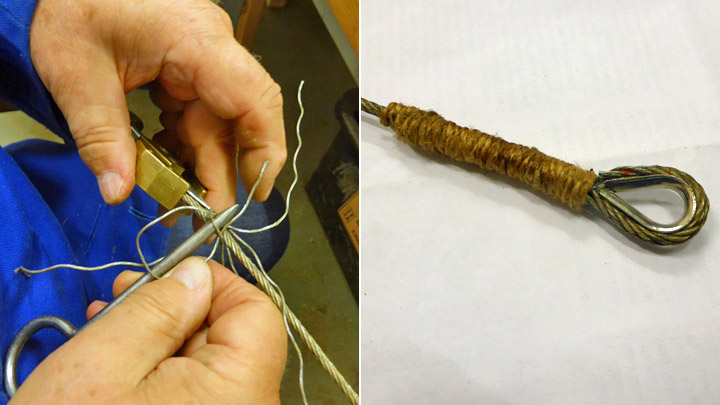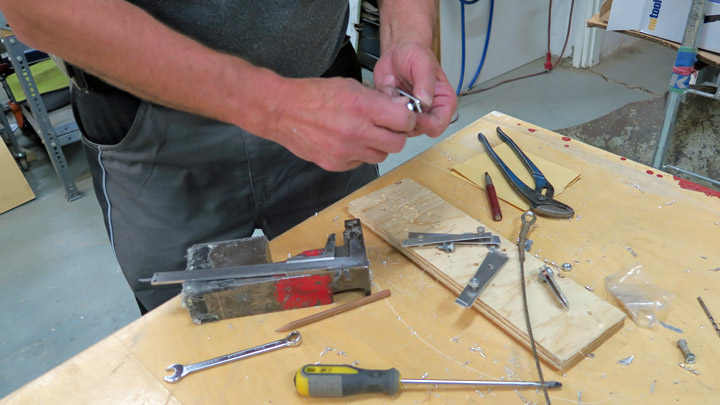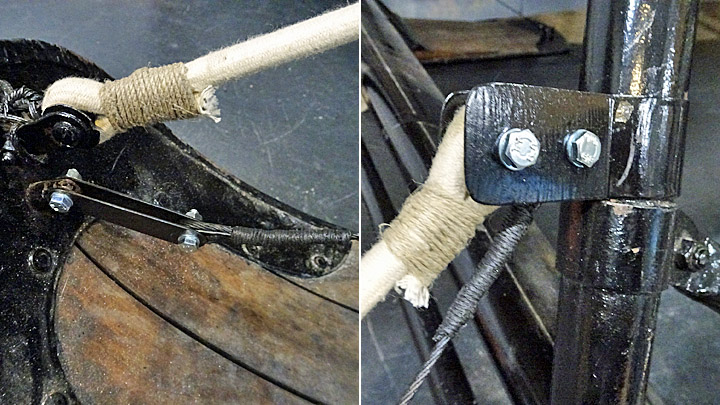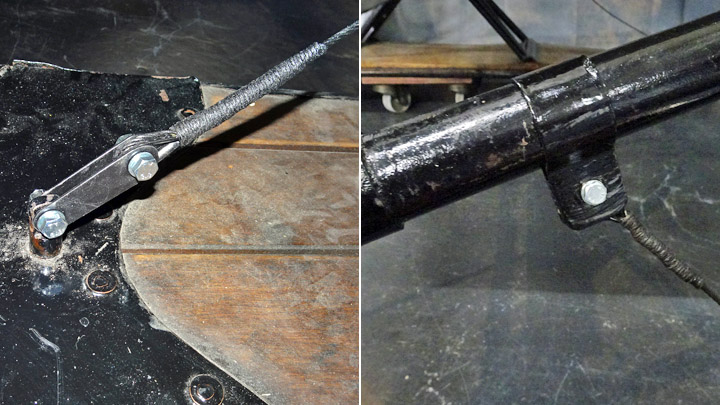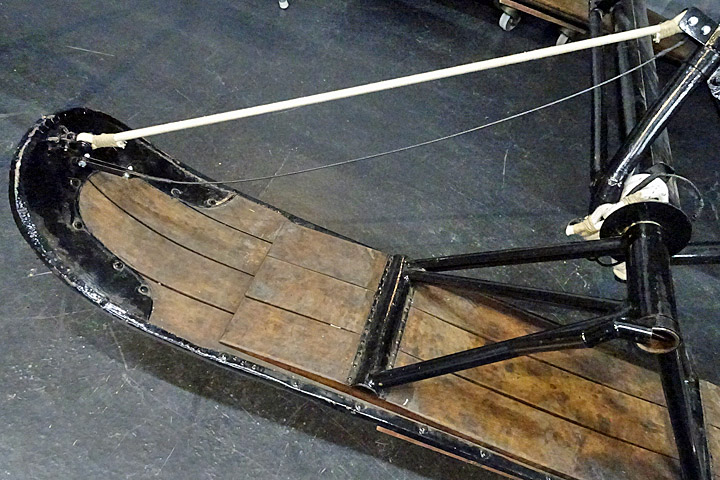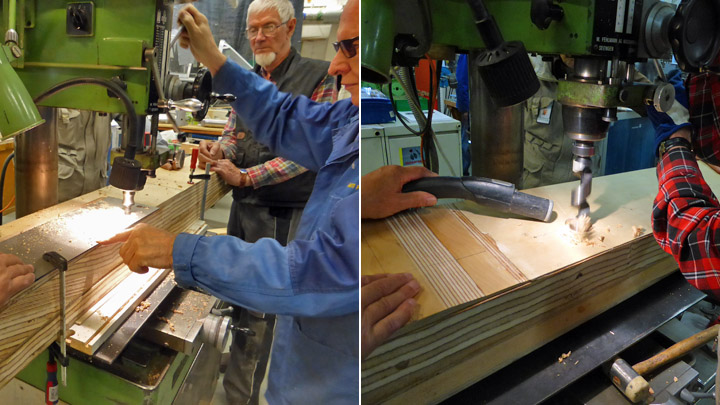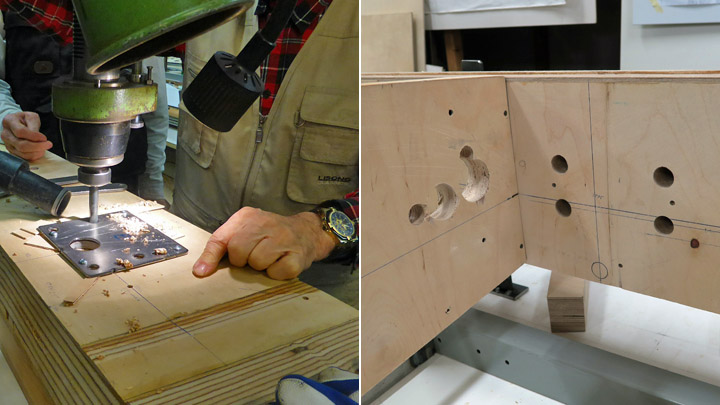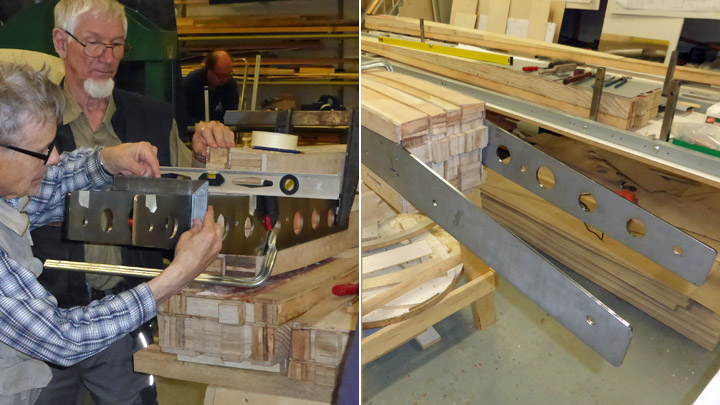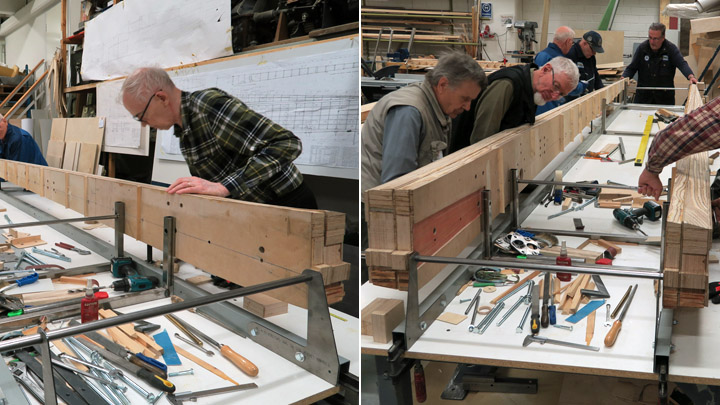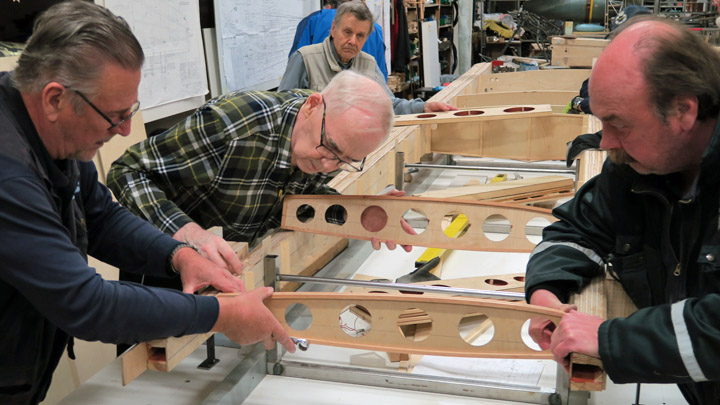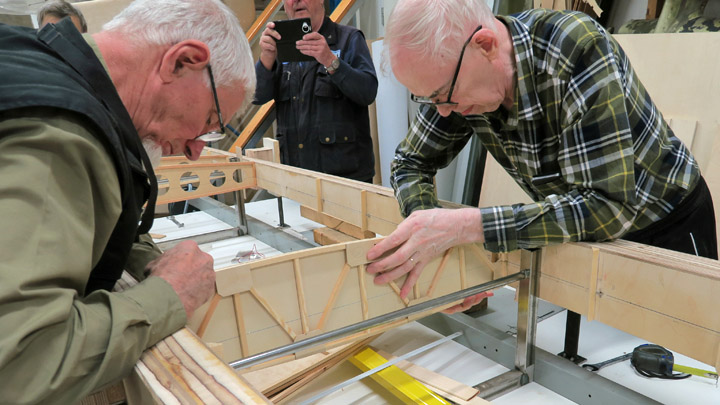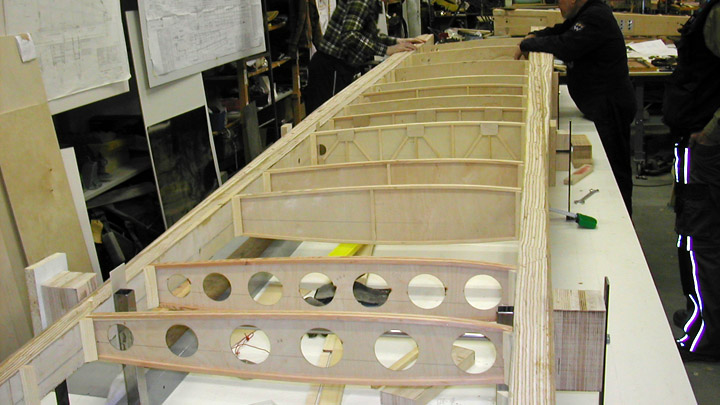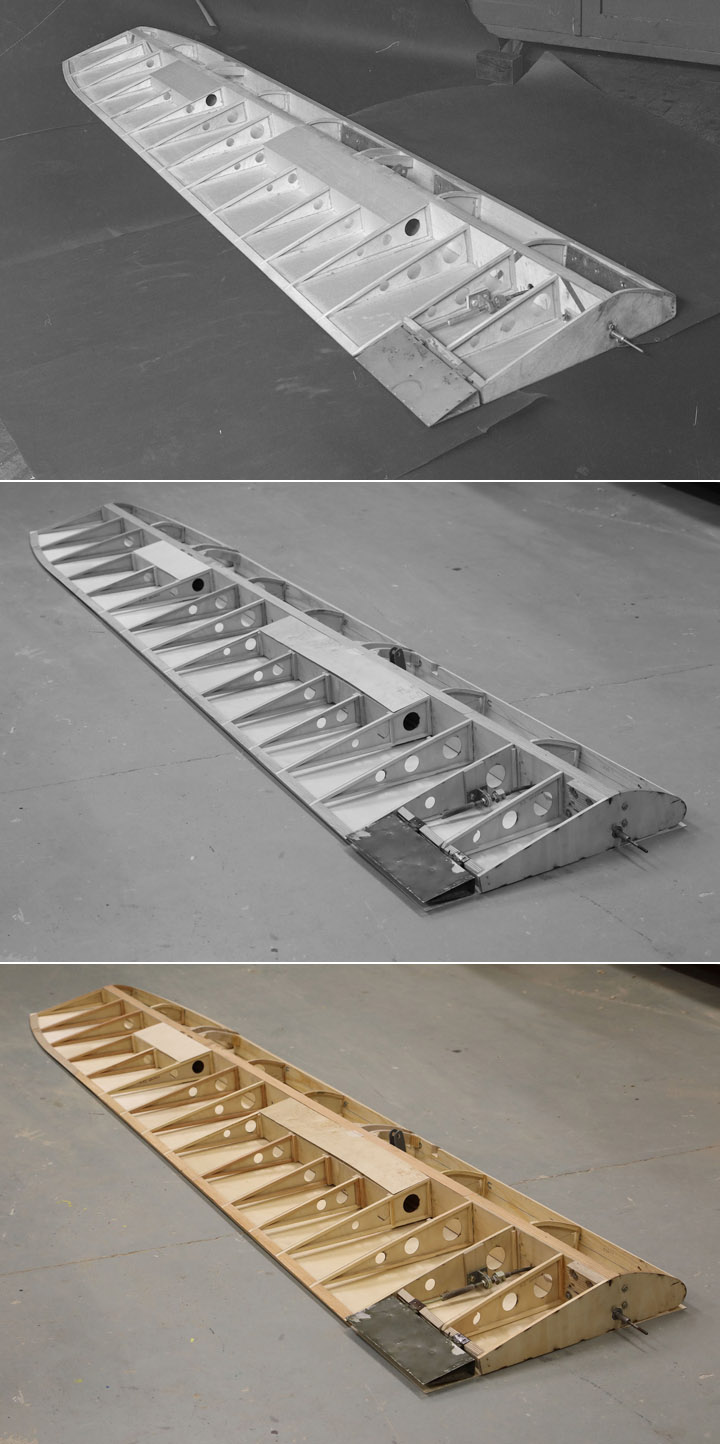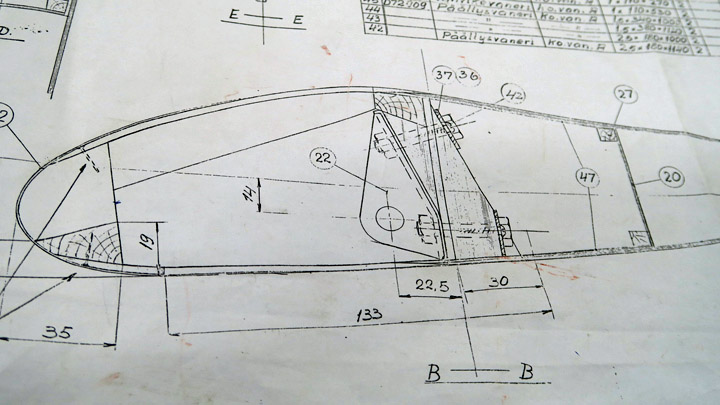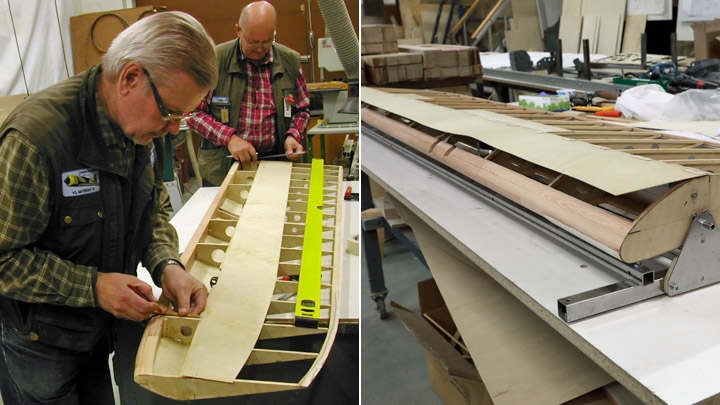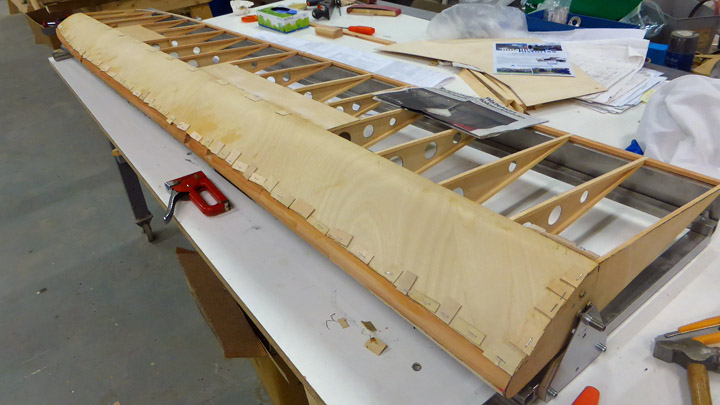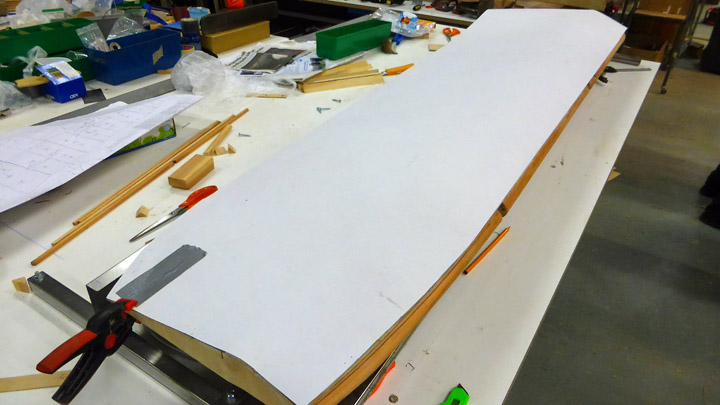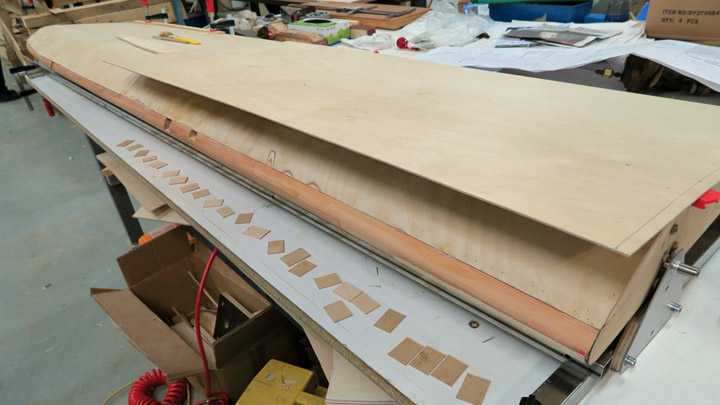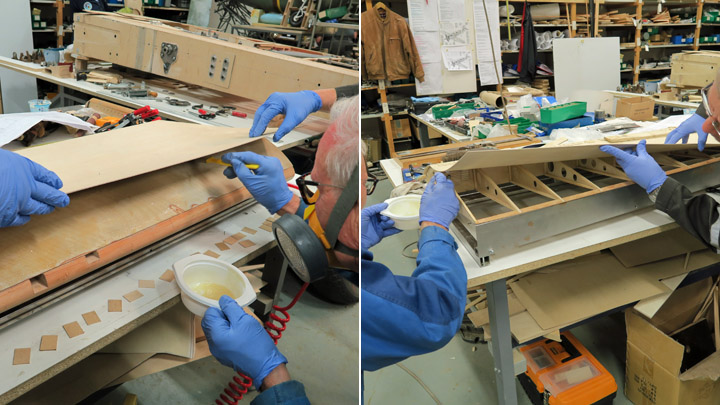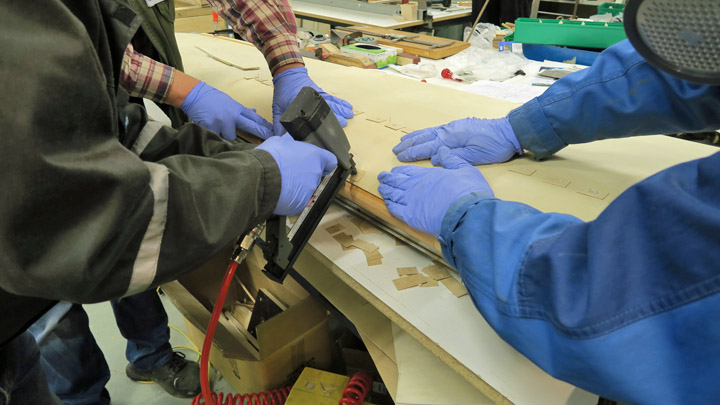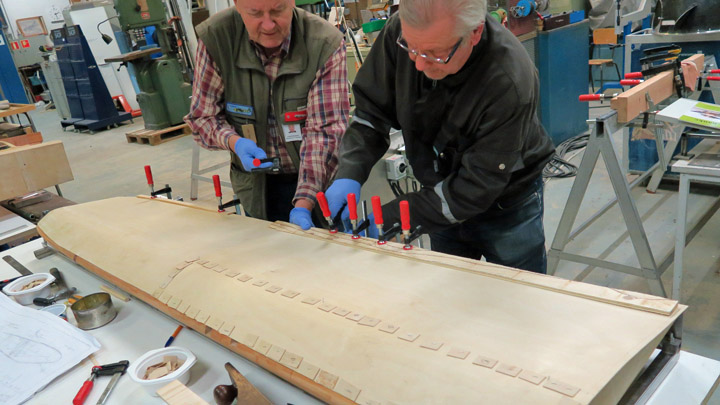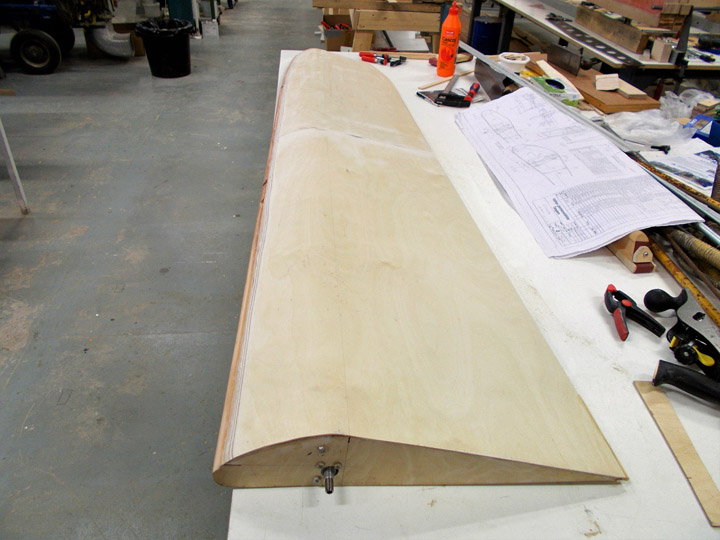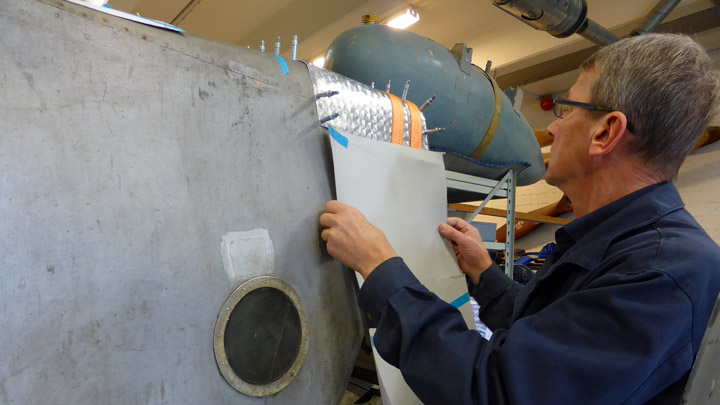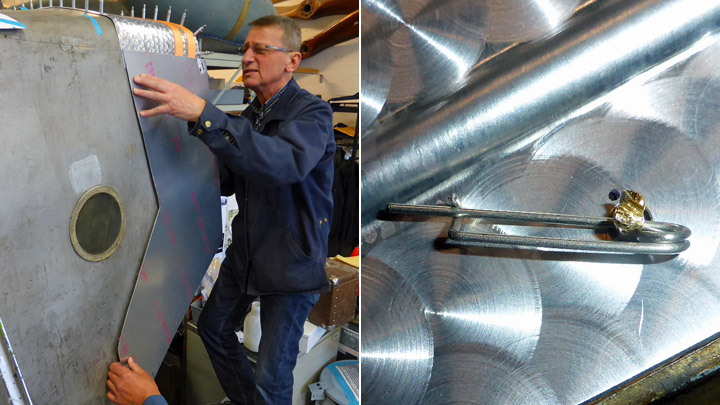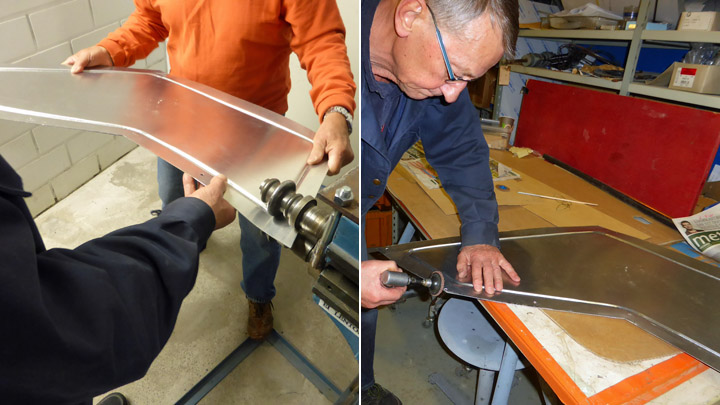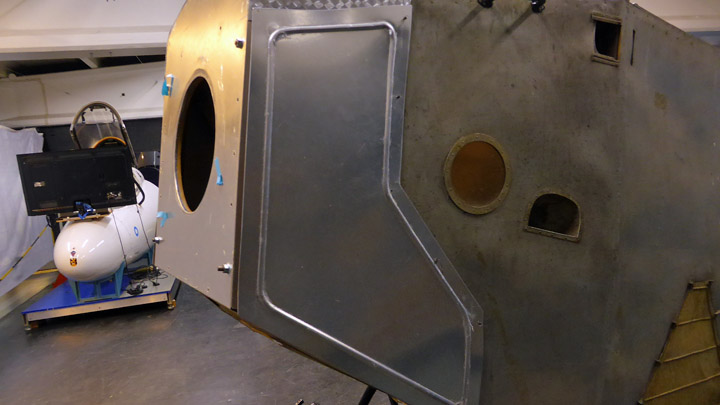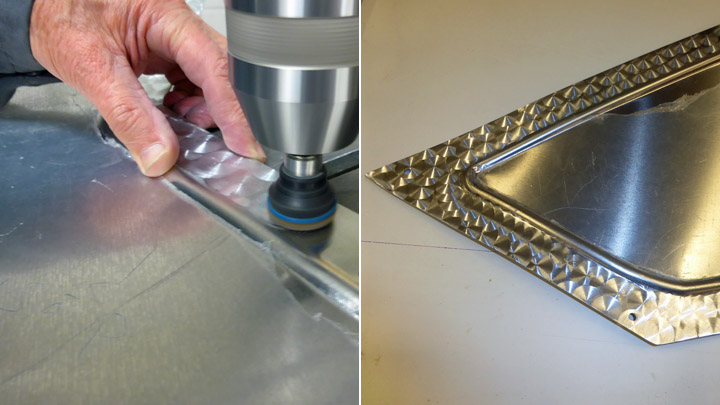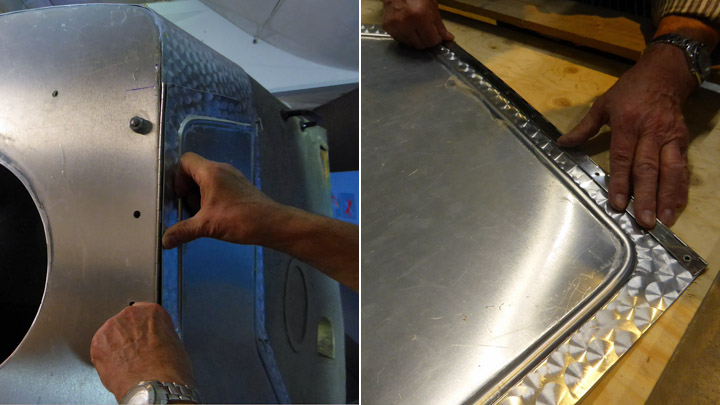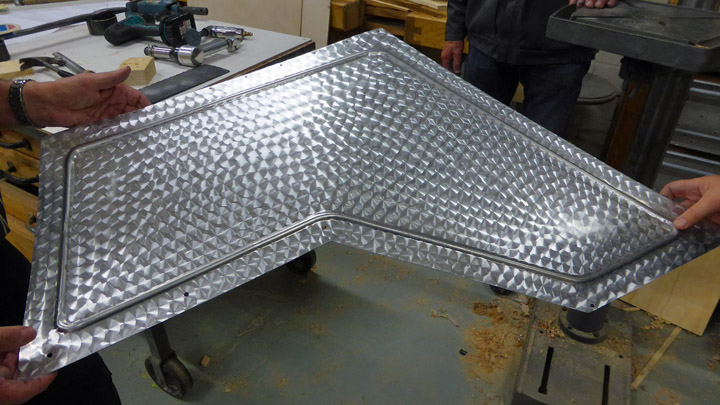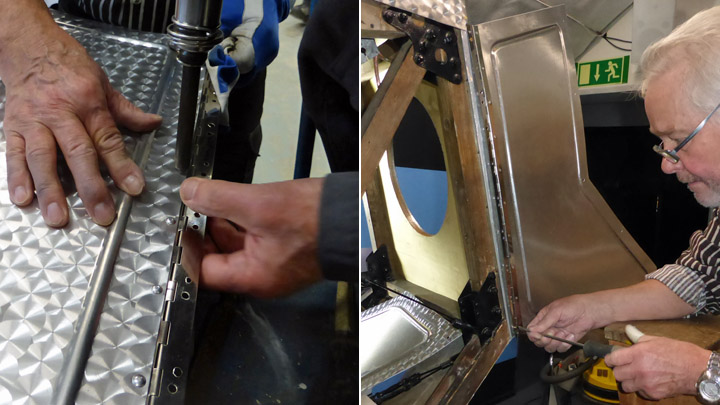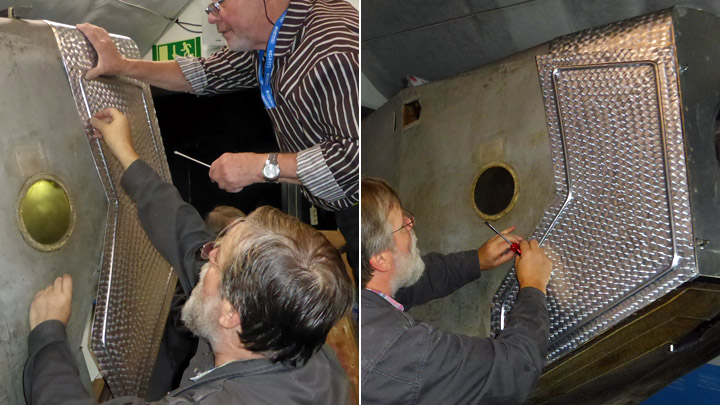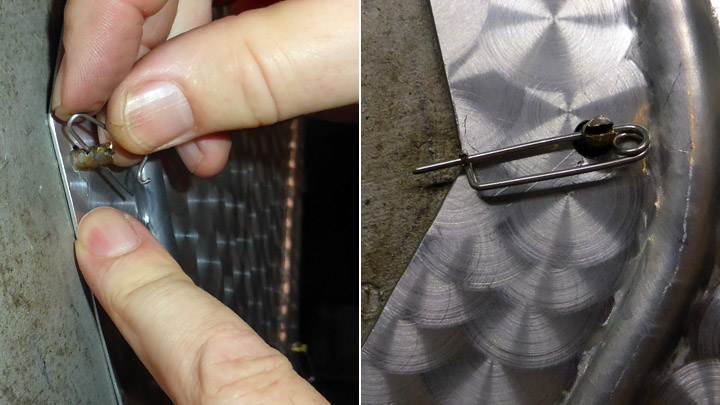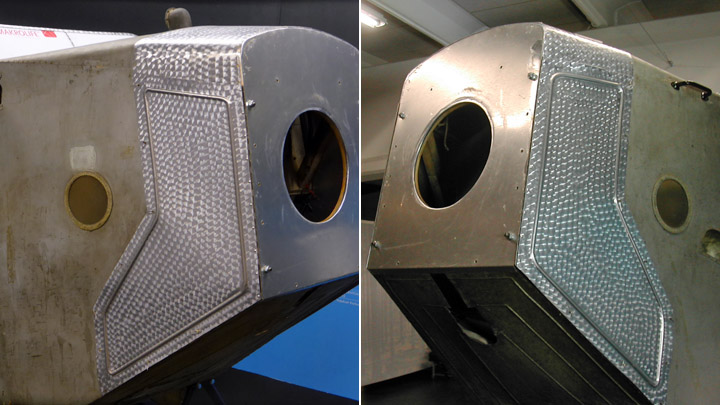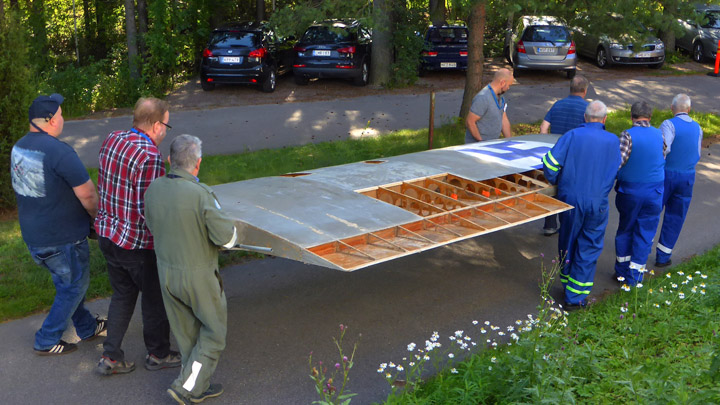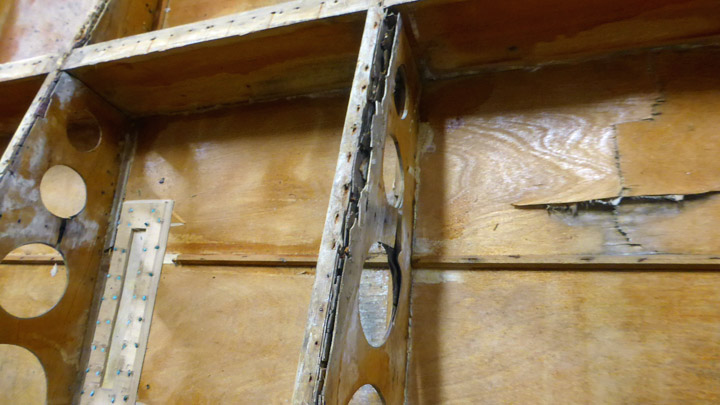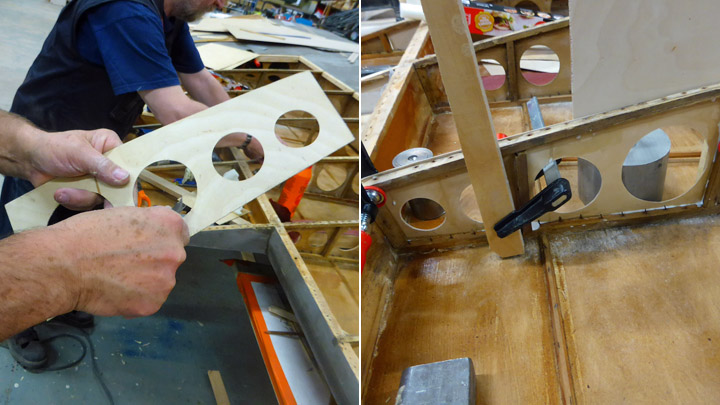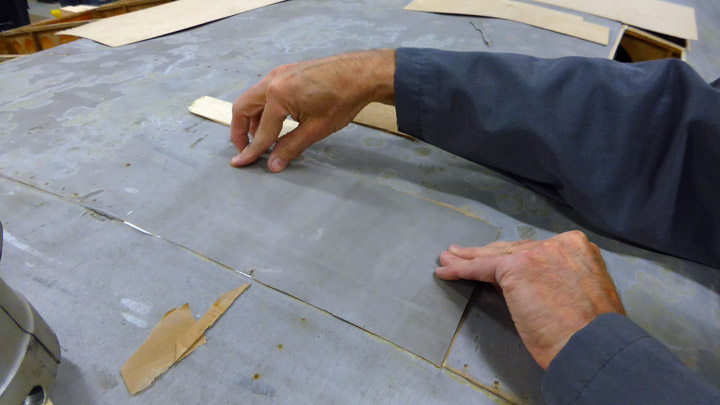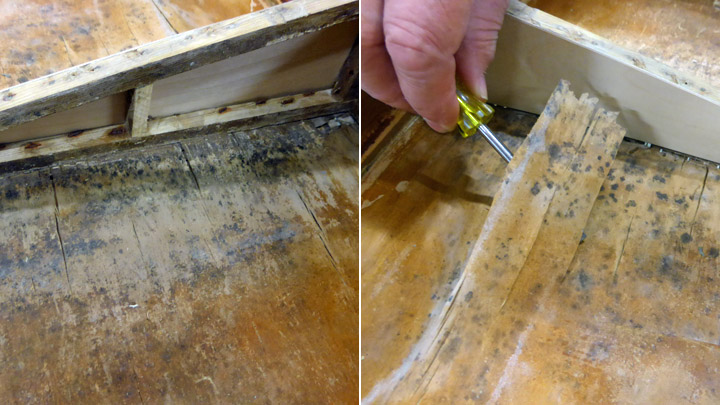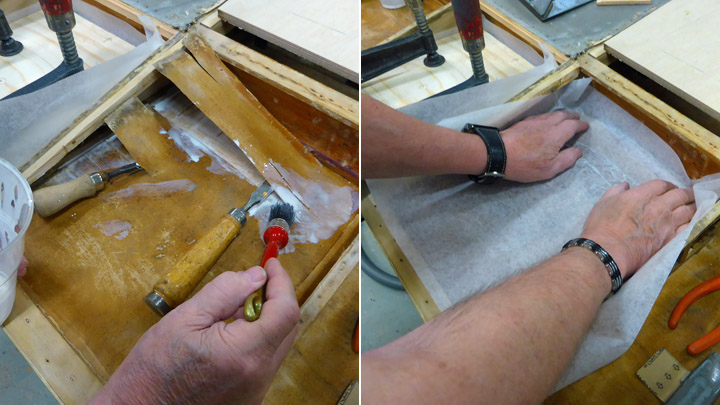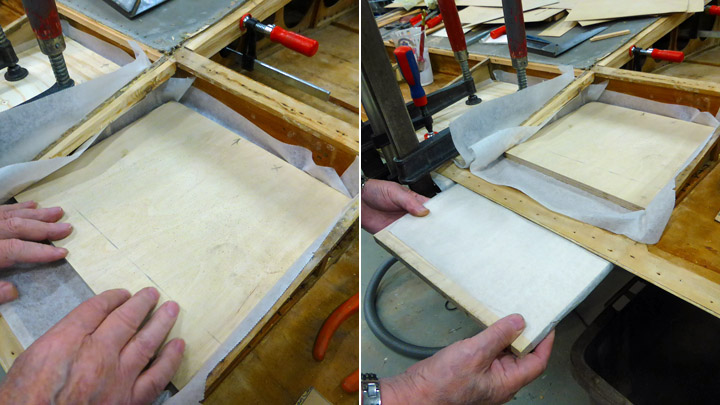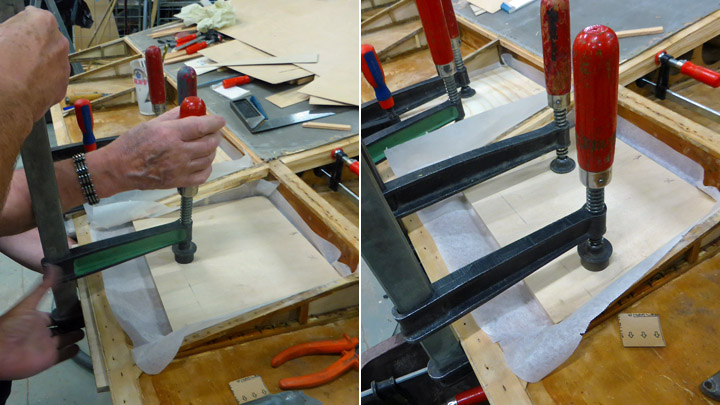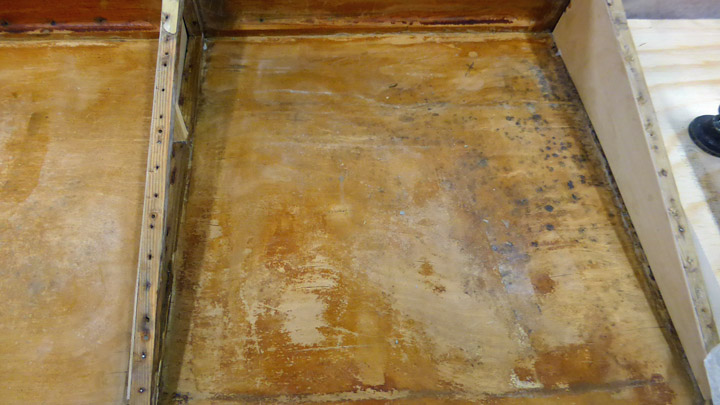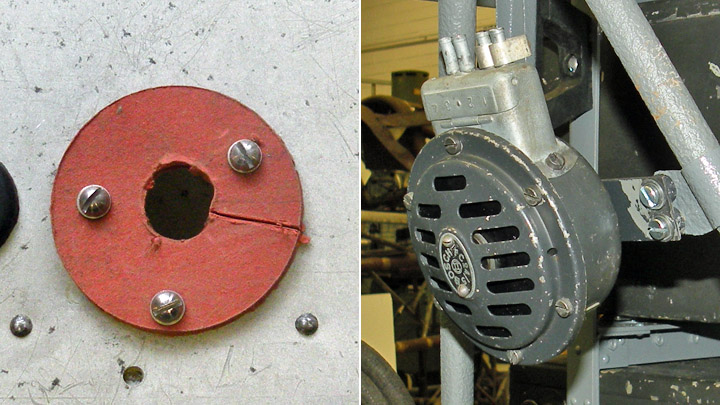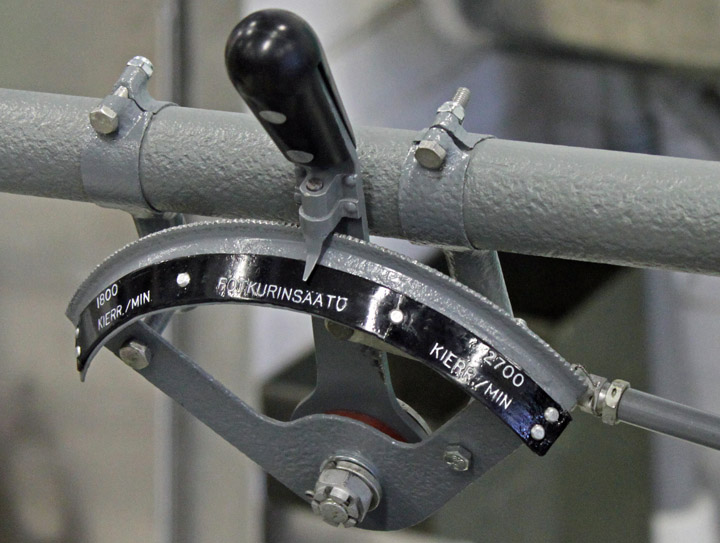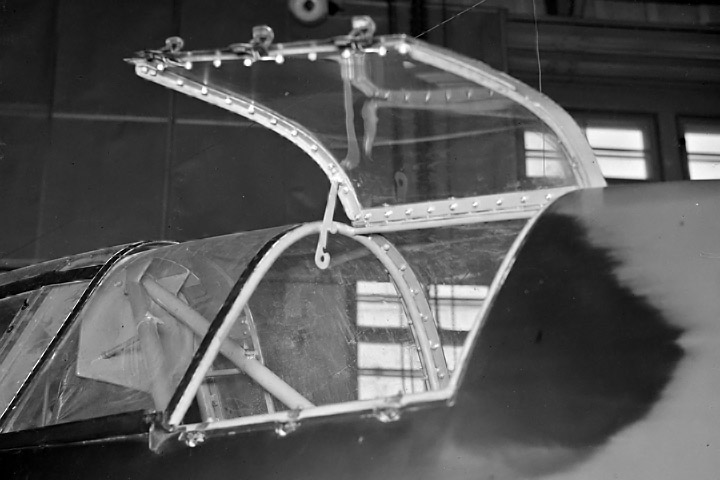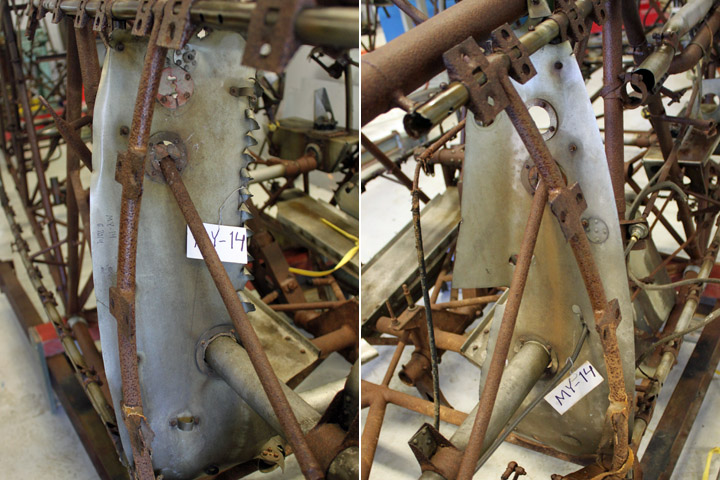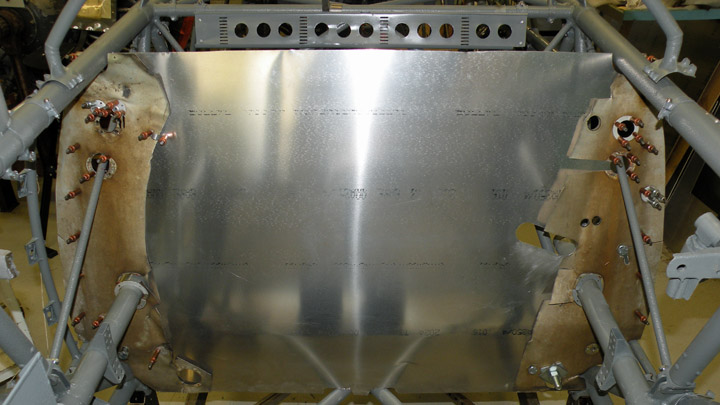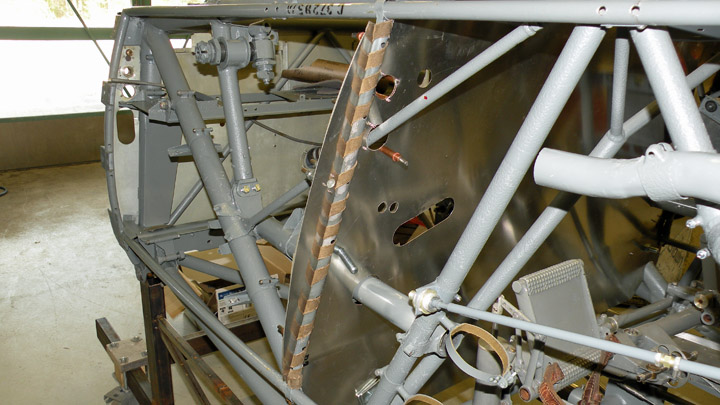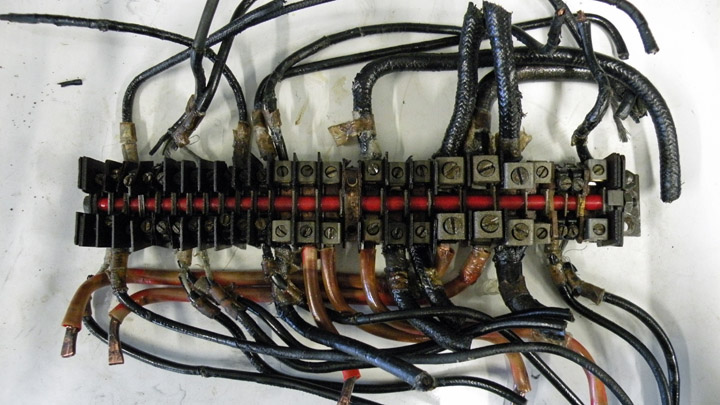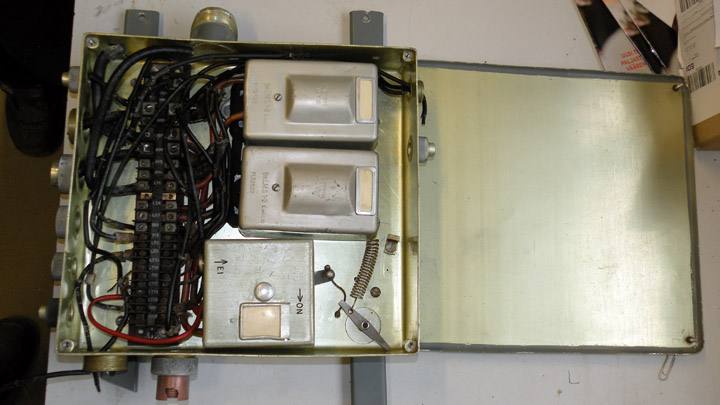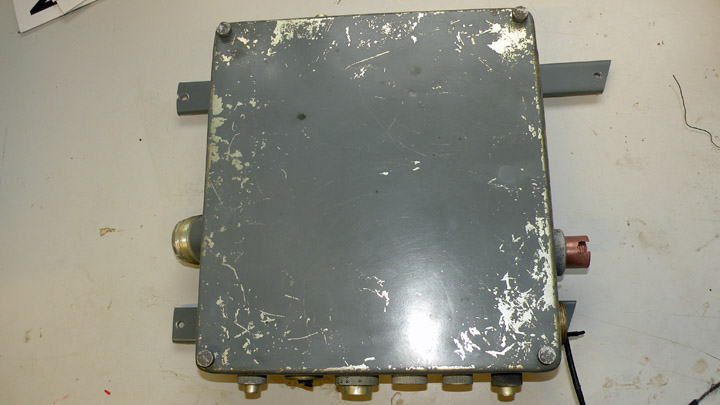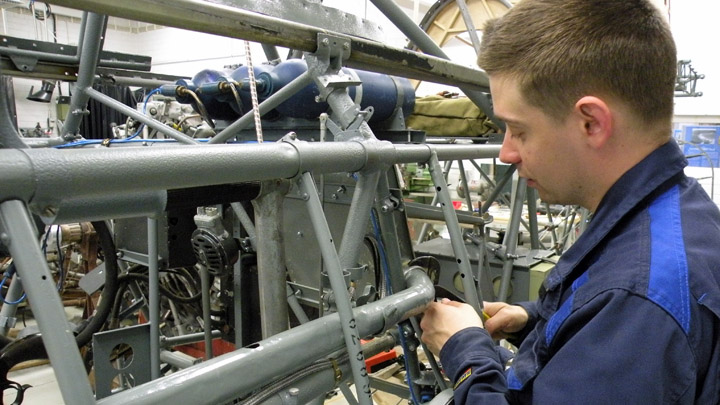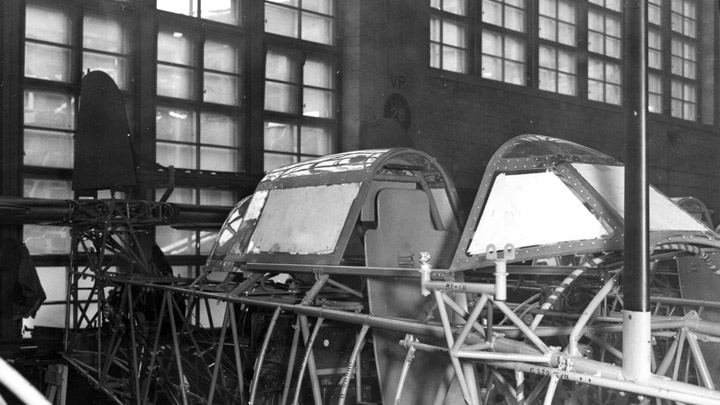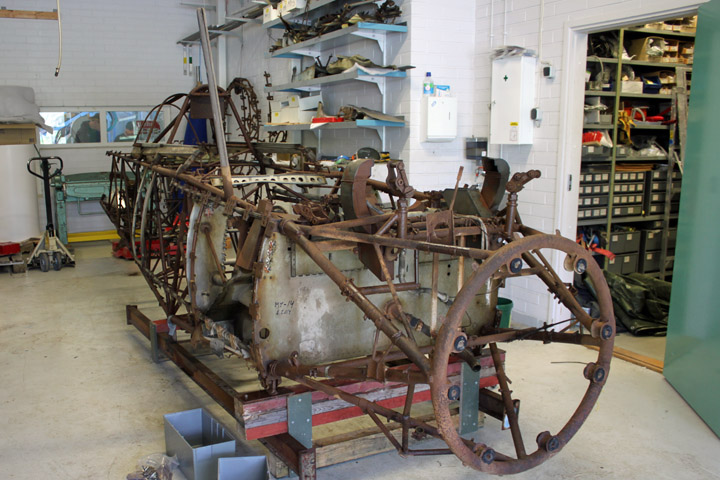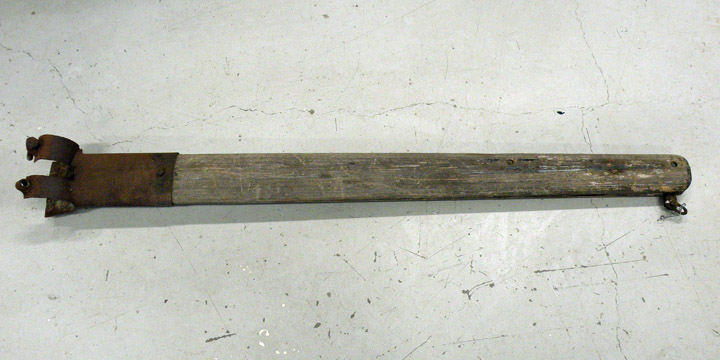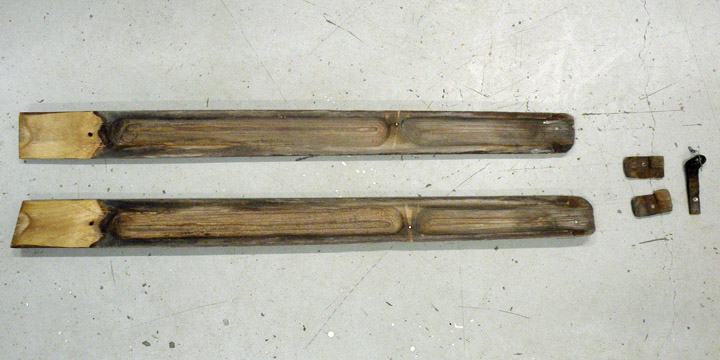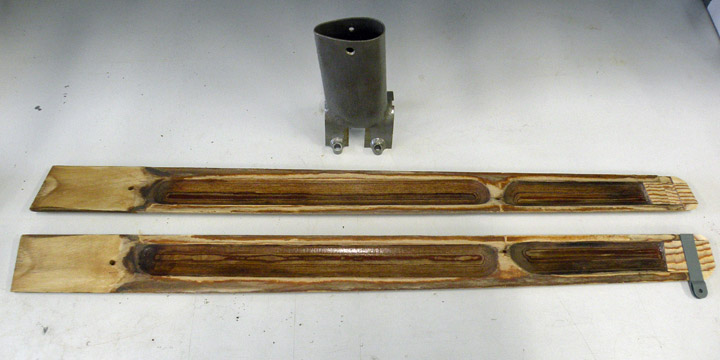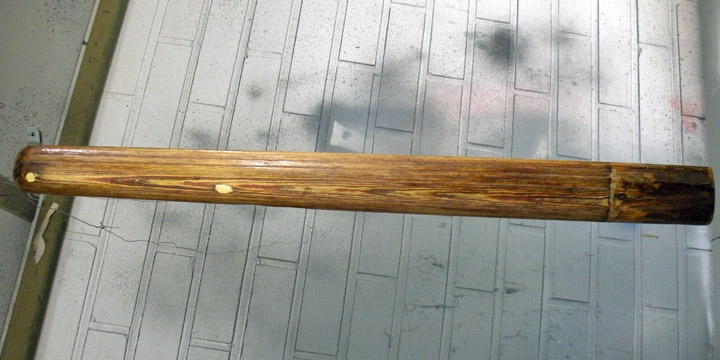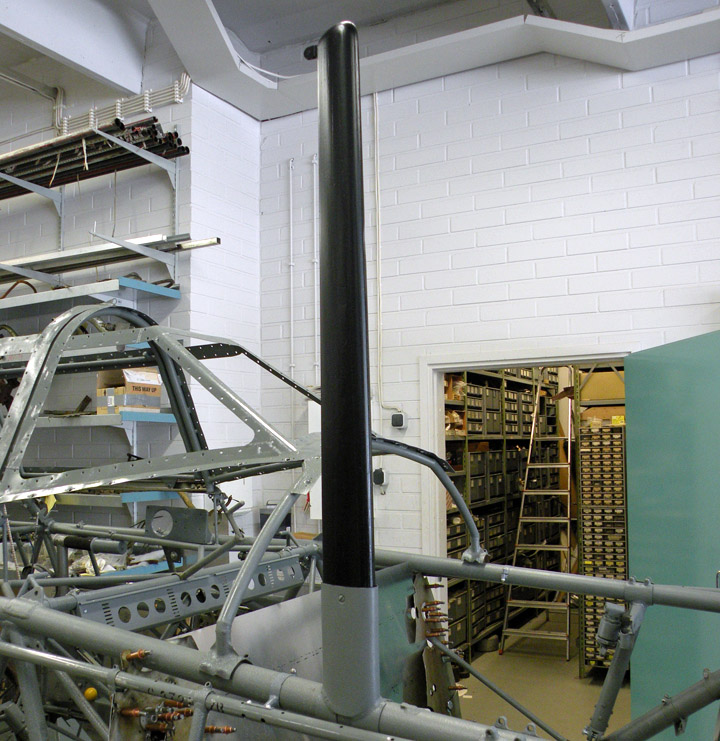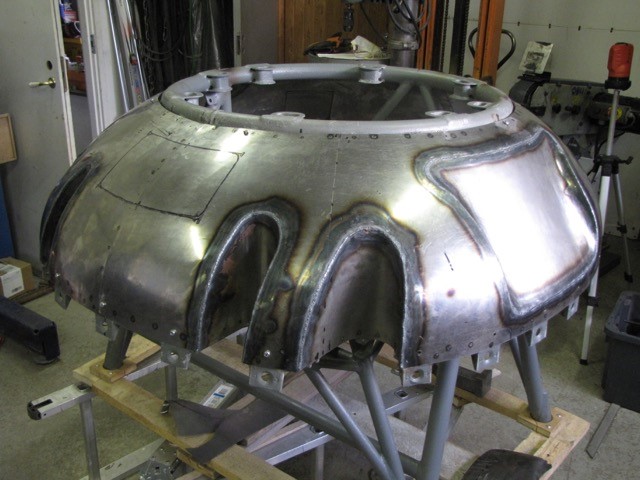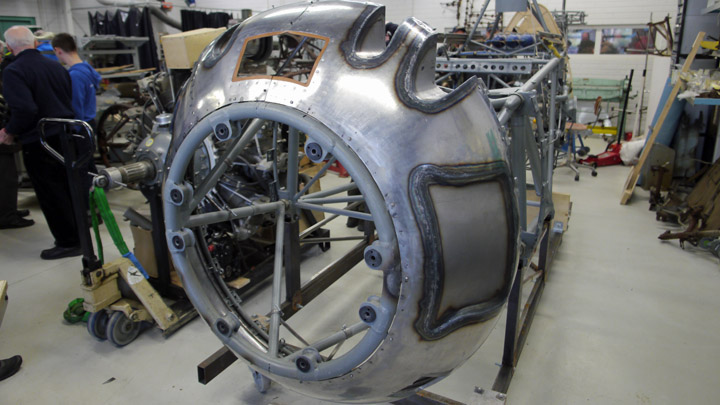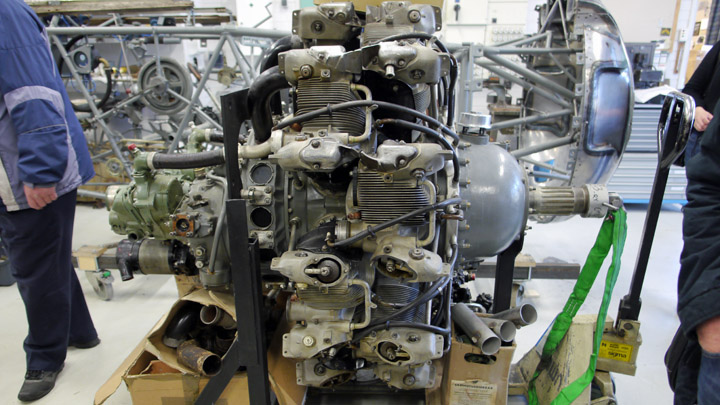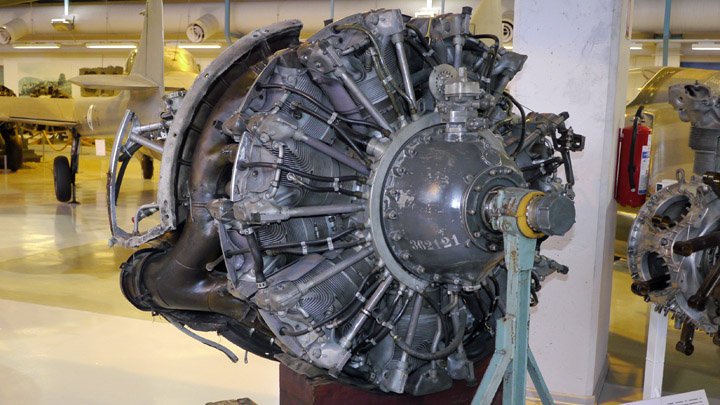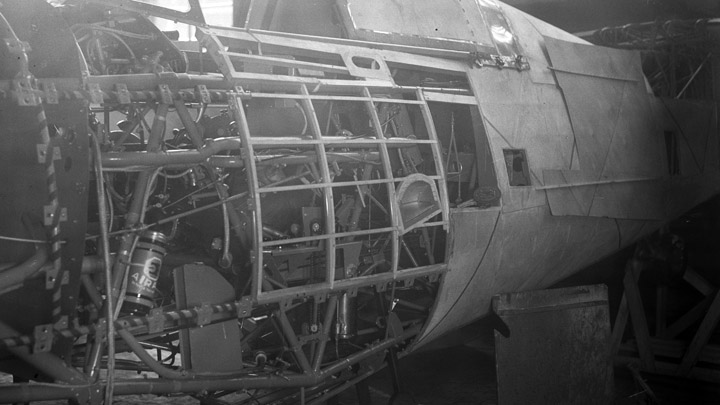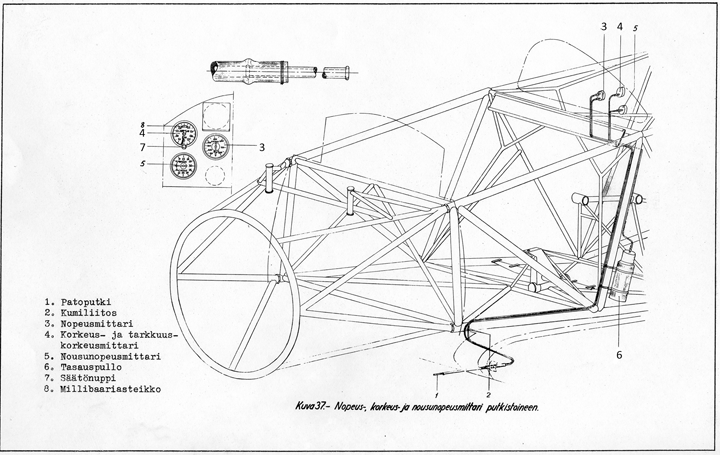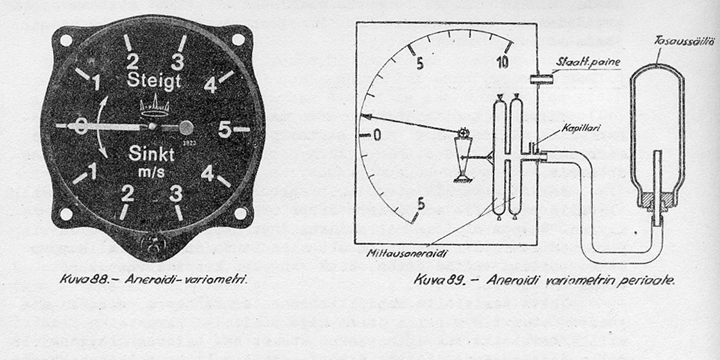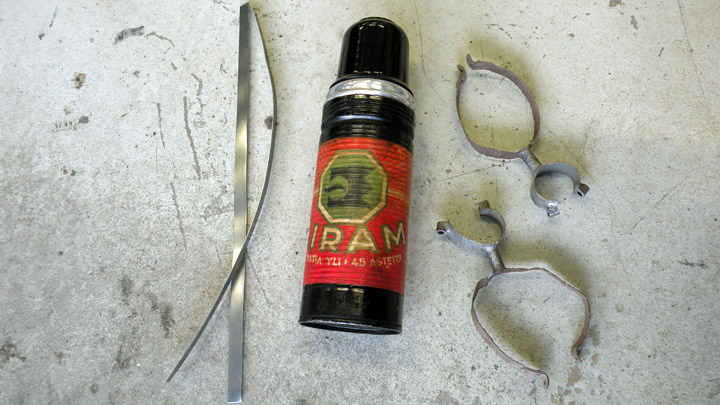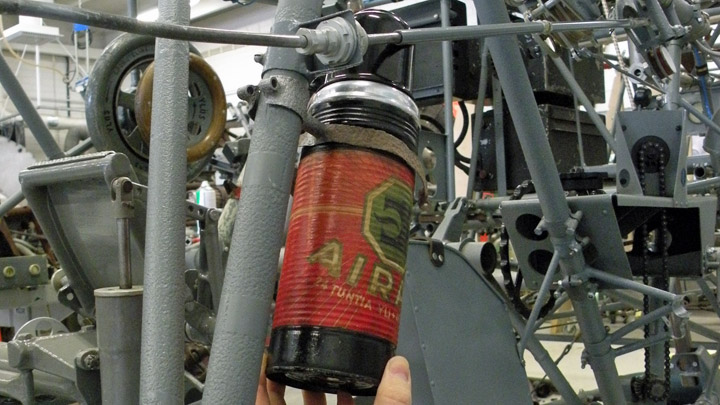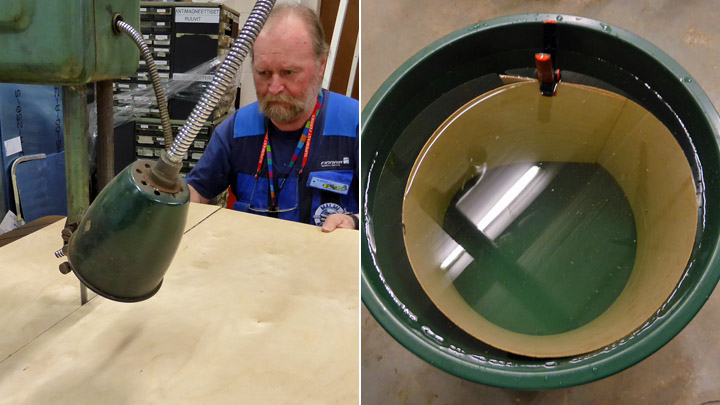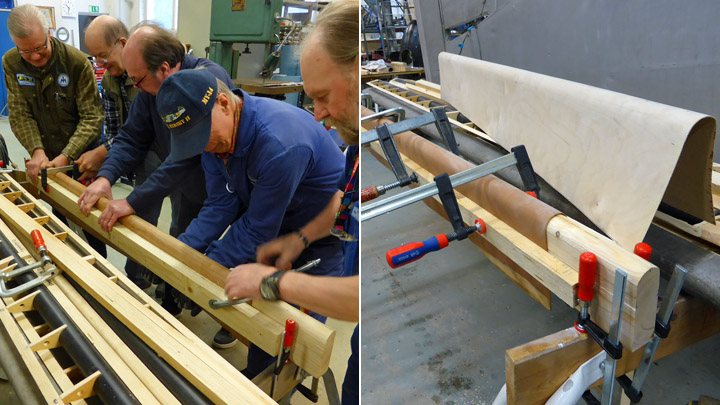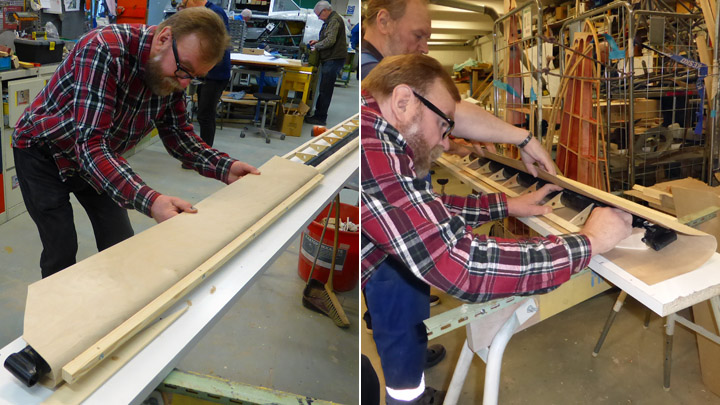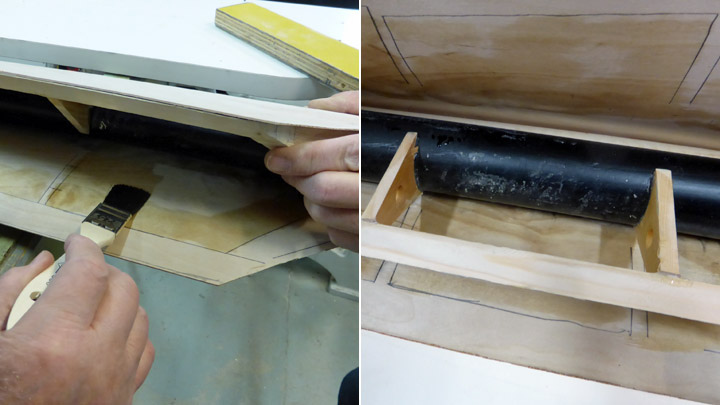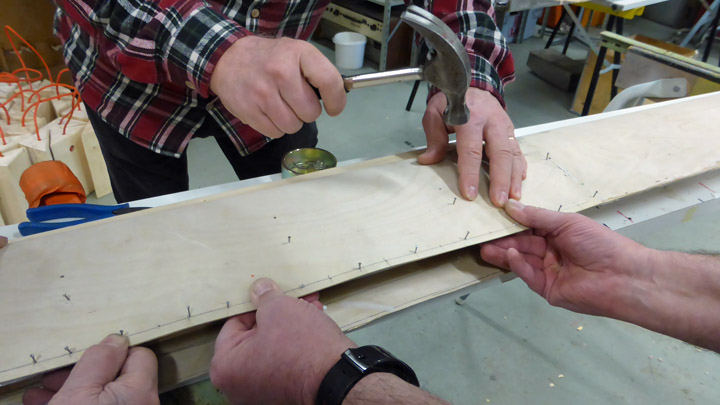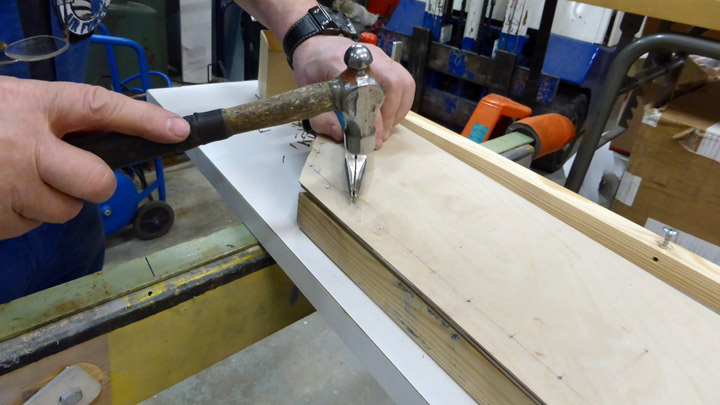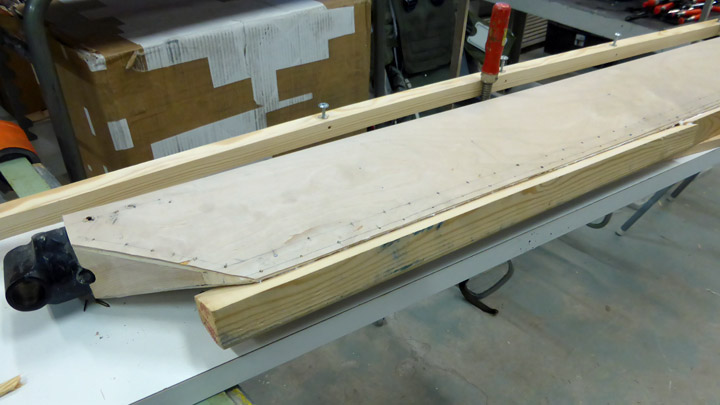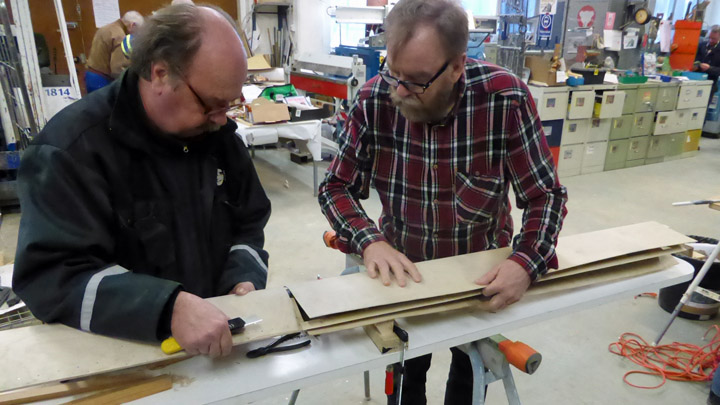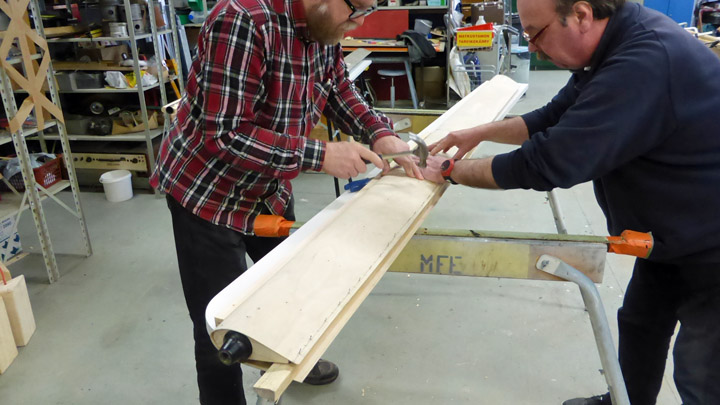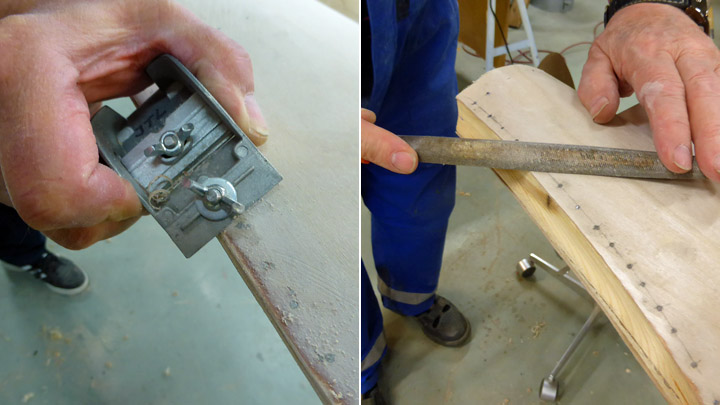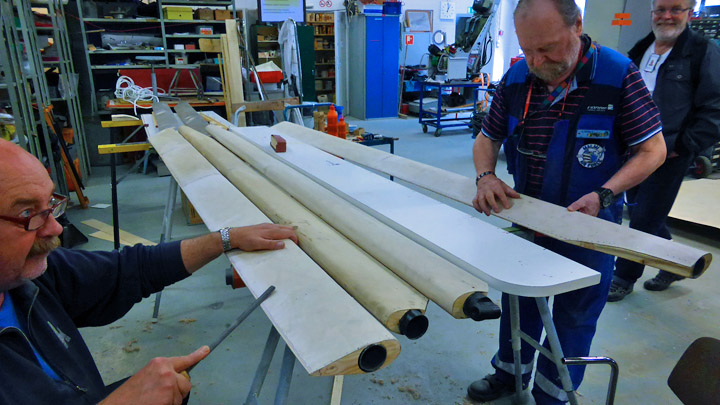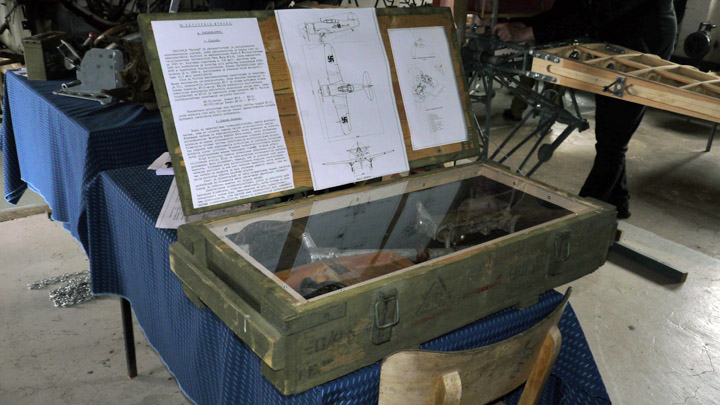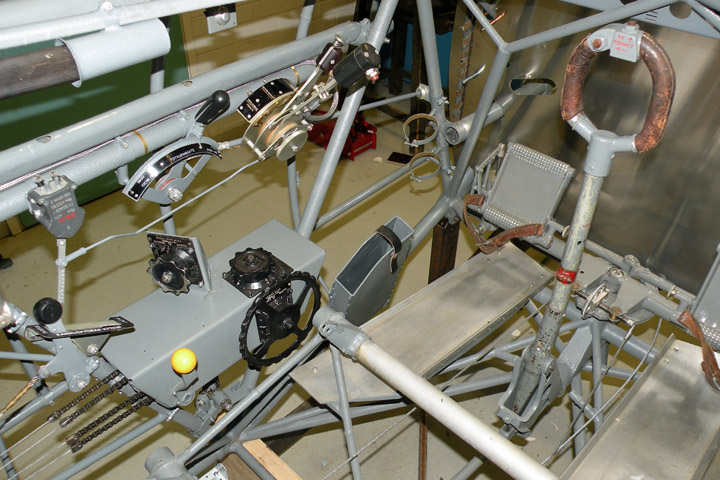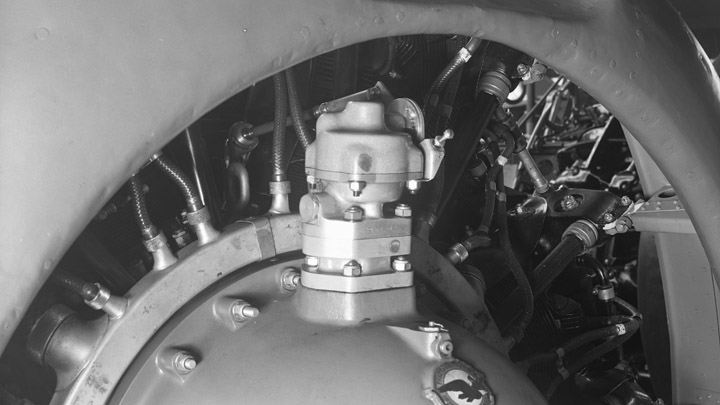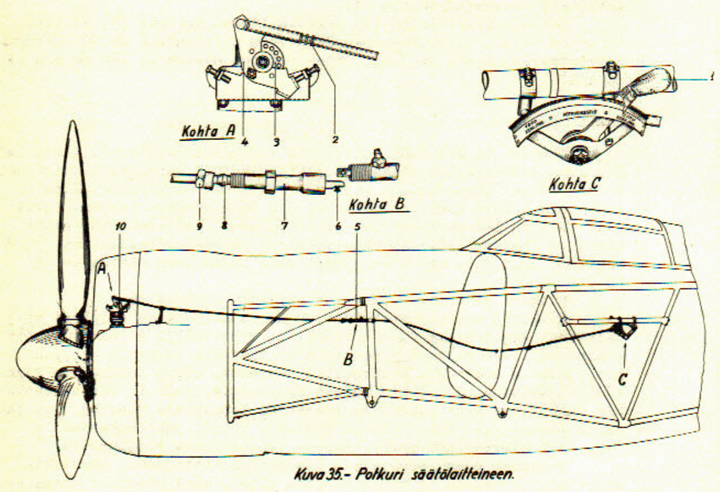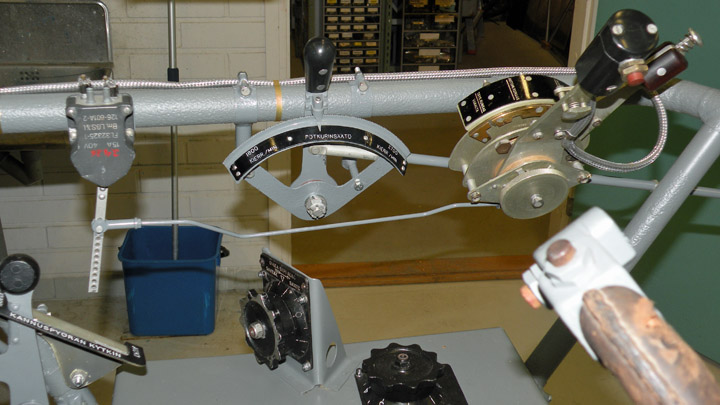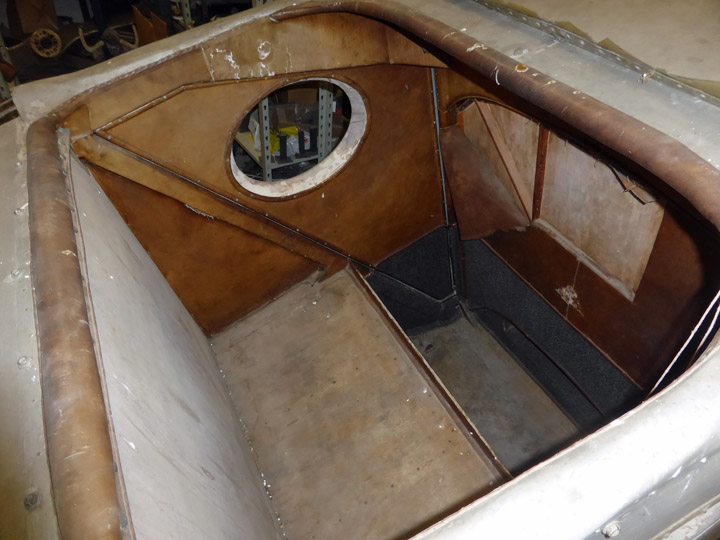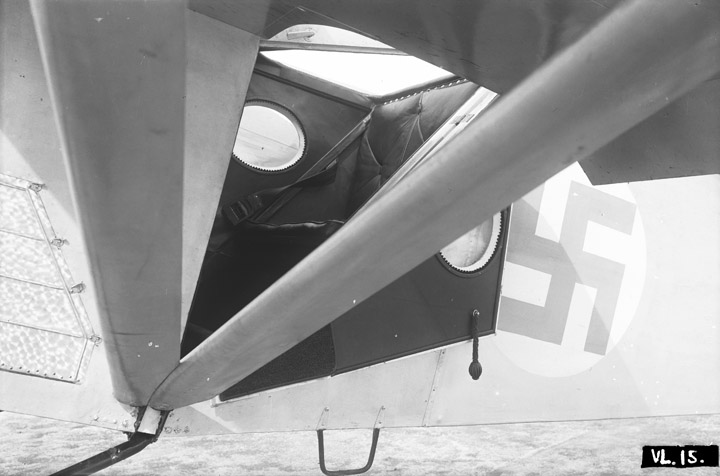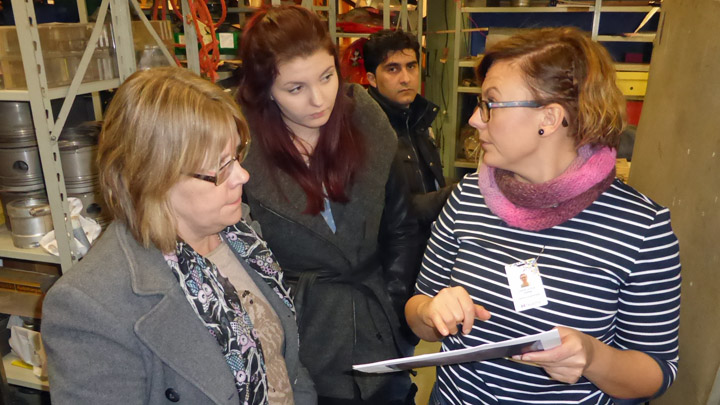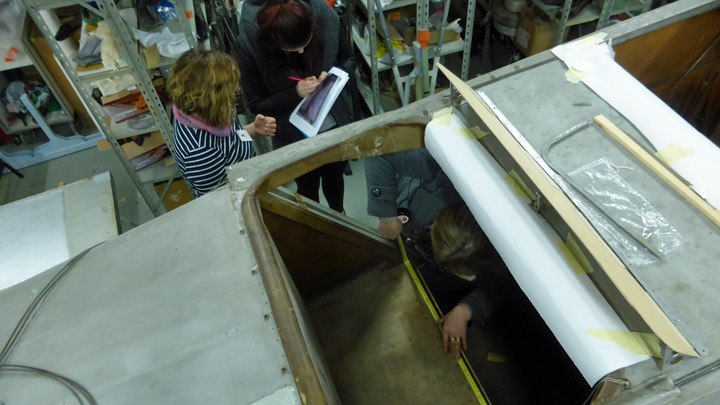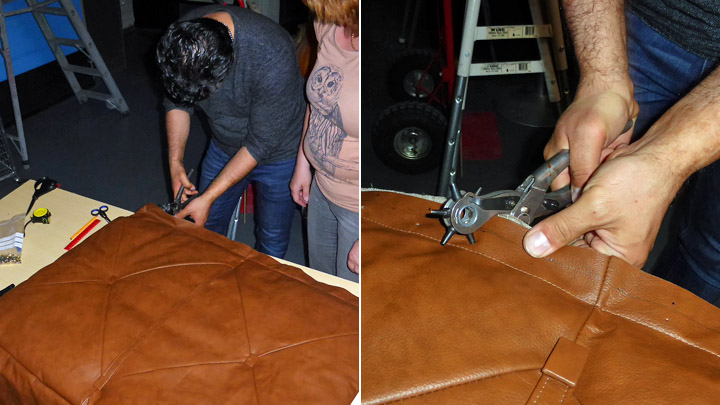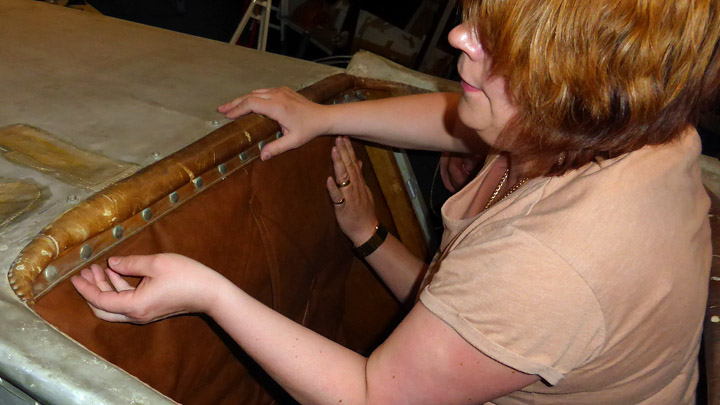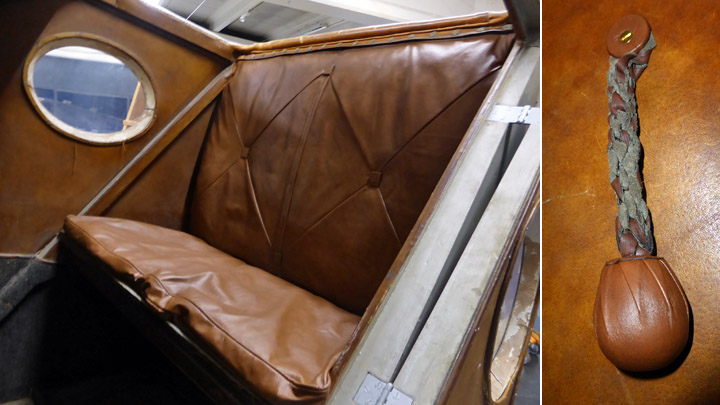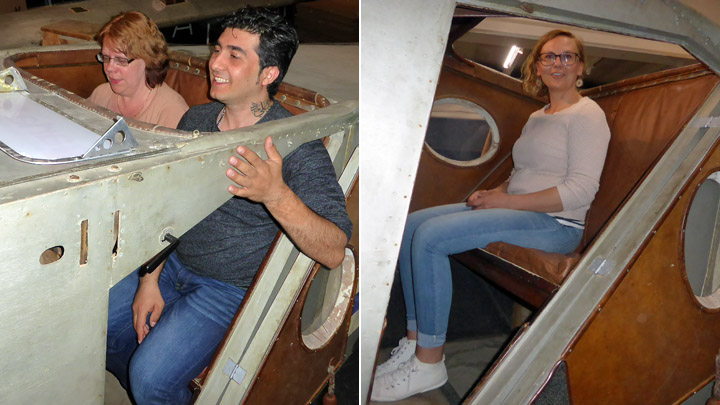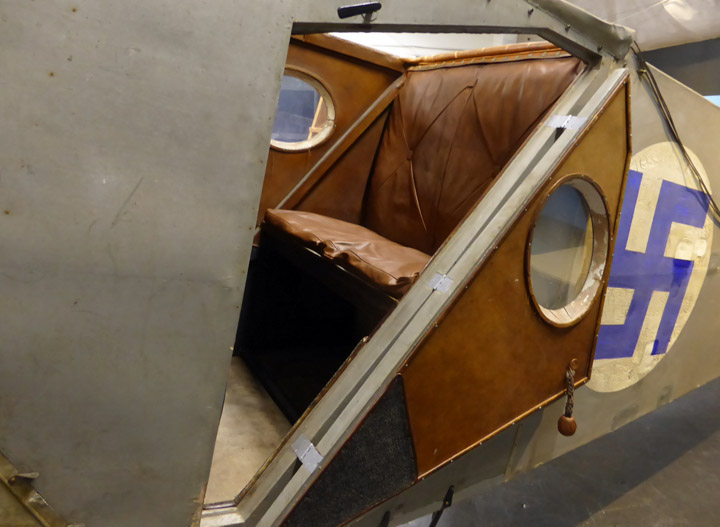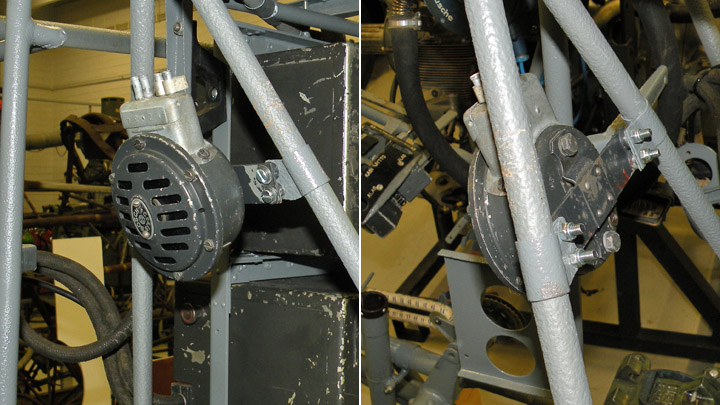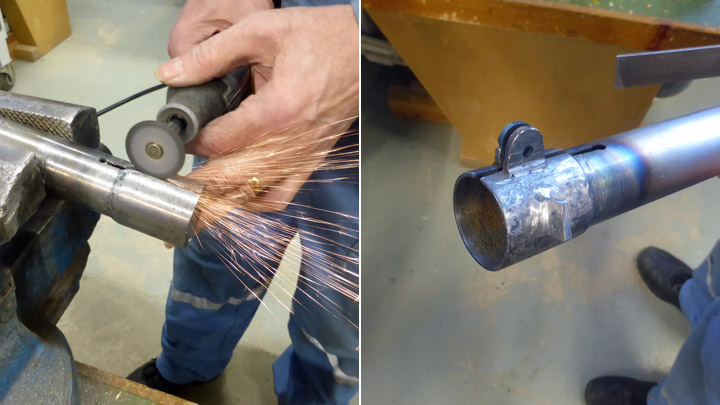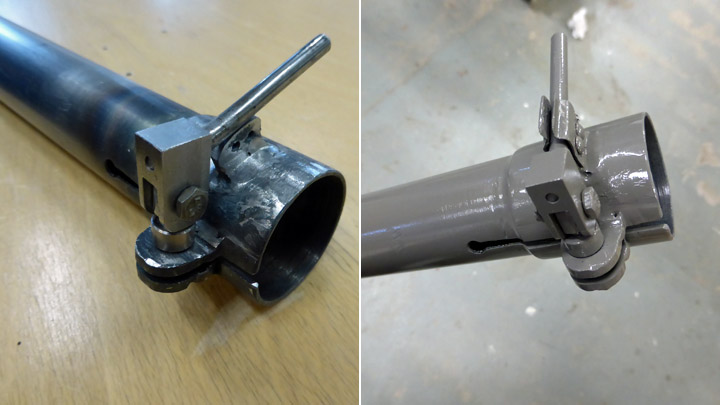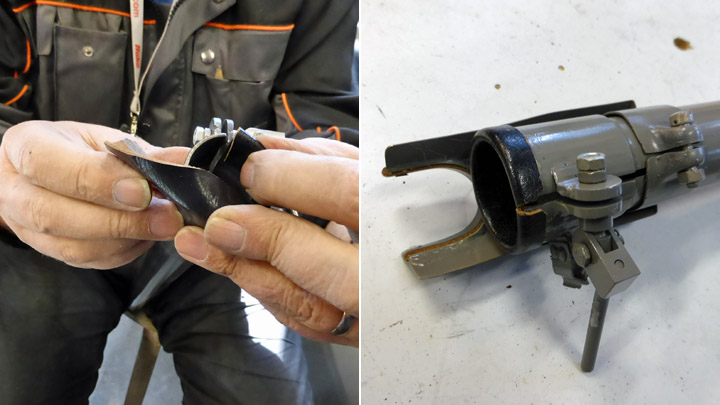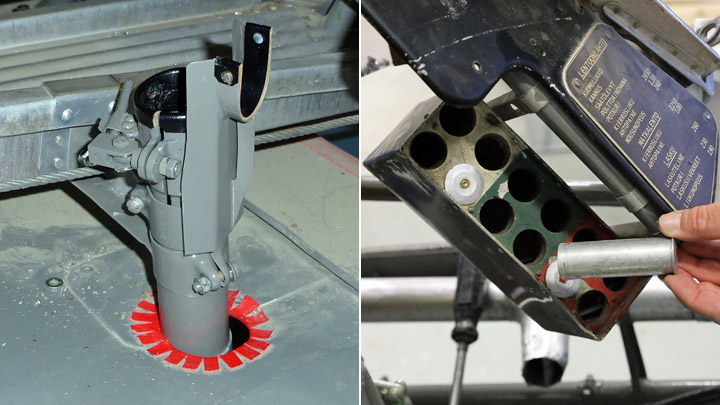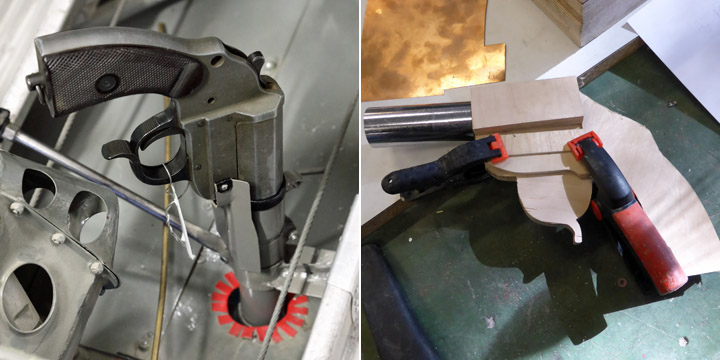Myrsky rear fuselage coveringPerjantai 26.1.2018 - Member of Tuesday Club The VL Myrsky is a fighter plane having mixed construction. The wings are made of wood and the fuselage consists of a tubular steel frame covered with a covering structure that gives the aircraft its shape. The rear fuselage covering consists of wooden upper, lower and side skin panels which are attached to the steel tube frame construction. The covering consists of wooden arc-shaped formers and wooden stringers and the skin is made of 1.2 mm plywood.
Photo: Finnish Aviation Museum photo archive In the first Myrsky serial production individuals the lower, side and upper coverings of the rear fuselage were built directly onto the tubular steel frame. Later the lower and upper coverings were pre-built on an assembly jig and attached onto the frame in one piece. The sides, however, were still built directly onto the frame of the plane. The upper skin plywood panel in the rear fuselage of Myrsky doesn’t meet the upper edge of the side skin panel in a butt joint but slightly overlaps the side panel. In a similar way the side skin plywood panel’s lower edge overlaps the upper edge of the lower panel’s upper edge. This is how the rear fuselage covering has a lap joint structure.
The Tuesday Club built tubular steel frame assembly jigs for assembling the upper and lower coverings of the Myrsky. The jig dimensions match accurately the dimensions of the Myrsky steel frame construction. This ensures that the upper and lower coverings which are completed on the jig will fit precisely the Myrsky tubular frame.
The assembly of the rear fuselage upper covering was started in the Tuesday club by attaching the formers on the jig. The wooden formers have been made in the youth workshop operated by the city of Vantaa. The jig frame has brackets for attaching the roots of the formers in the correct position. Corresponding brackets exist on the Myrsky steel frame.
When all the formers for the upper covering were in place, the wooden stringers connecting and supporting the formers were attached and modelled to their final shape.
When the formers and stringers had been glued together, the upper covering skin plywood could be preliminarily installed. The skin on the upper and lower covering will be finished later.
The upper and lower coverings without the plywood skin have already been preliminarily assembled on the Myrsky MY-14 fuselage at the Finnish Air Force Museum.
Photo: Finnish Air Force Museum The Tuesday Club has made two rear fuselage coverings for the Myrsky. Why two? One covering belongs to the Myrsky MY-14 which is under restoration. But what about the other one? It will be assembled on the less famous Myrsky MY-5 steel frame. The MY-5 frame is one of the four existing but damaged Myrsky tubular steel frames.
The MY-5 steel frame has been reserved for the model wing which has been built in the Myrsky restoration project. The model wing is the 2,5 m long root part of the right wing. When the model wing is completed, it will be attached to the MY-5 frame. The MY-5 frame will also have another model wing: the root part of the left wing, about 1 m long which will be built in the restoration project. The other rear fuselage upper covering which was made now will be assembled on this frame. Maybe the Tuesday Club will have the energy to build also the lower and side coverings for the MY-5... The Myrsky MY-5 frame with its short model wings and upper coverings will eventually be placed on display at the Finnish Aviation Museum. At the moment the MY-5 tubular steel frame lies unrestored at the Finnish Air Force Museum in Tikkakoski. Photos: Unless separately mentioned: Lassi Karivalo. |
|
Avainsanat: aviation history, restoring, old aircraft, VL Myrsky II, MY-14 |
Kurki has a wing!Lauantai 30.12.2017 - Member of Tuesday Club A lot of work was needed before the right wing of the I.V.L. K.1 Kurki was ready for testing how to attach it to the fuselage. The Tuesday Club of the Aviation Museum Society had repaired the plywood covering of the wing and the damages in the inner structures and built the missing four wing struts. Also the restoration of the Kurki fuselage was almost completed, so it was time to test how the wing would be attached.
The Kurki wing had been restored in the work space of the Finnish Aviation Museum and now it was carried to the mid-hall where the restored Kurki fuselage was waiting. A lot of excitement was in the air when the assembly work was started by picking the wing up by a stacker and moving it slowly to the proper installation position.
Boards had been placed on the fork of the stacker so that the whole length of the wing could be supported. Two cargo lashes were attached to the ceiling beam of the hall and wrapped around the wing to ensure the lifting. The cargo lashes were tightened as the stacker lifted the wing higher.
When the correct installation height had been reached, the stacker was moved away and the cargo lashes now carried the whole weight of the wing. The wing was tilted so that the locating lugs were in line with the wing assembly holes in the fuselage.
Then the wing was pushed against the Kurki fuselage and the locating lugs at the root of the wing slid into the holes in the fuselage. The installation was surprisingly easy and the lugs were locked in place using bolts.
More stress was coming: would the two original wing struts and the two new ones (which had been made based on the original ones) fit the Kurki wing now that it was in place? The new wing struts had been made assuming that the two old wing struts found in the Vesivehmaa museum hall (and used as models) had belonged to Kurki. There was no evidence to support this assumption.
The original and repaired straight wing strut on the leading edge of the wing was installed first. The quill-shaped fastener at the lower end of the wing strut was attached to the brackets on the fuselage. This went well and the connection was secured with a bolt. Then the upper end of the front wing strut was lifted up in an angle to meet the brackets on the wing. After some adjustments the fastener was attached to the brackets. Now the front wing strut had been installed.
It was time to install the straight wing strut to the rear part of the wing. The rear wing strut had been made based on the original and repaired strut main tube and covered with plywood. The wing strut had been attached by its lower end to the brackets on the fuselage. Then a problem arose. When the strut was lifted up in an angle towards the brackets on the wing, the strut was positioned about 15 cm in front of the brackets. This meant that the brackets on the fuselage and on the wing were not in a perpendicular line. The brackets on the wing are located about 10 cm further back than the ones on the fuselage.
When the wing strut was rotated 180 degrees around its axis (the leading edge of the strut now pointing towards the trailing edge of the wing), the wing strut settled nicely between the brackets on the fuselage and the brackets on the wing. The Tuesday Club team noticed that the fastening quill on the lower end of the wing strut tube had been originally welded at an angle of 5 degrees to compensate the difference in the positioning of the brackets on the wing and the fuselage. This was something the team hadn’t noticed earlier and this couldn’t have been observed by naked eye.
The team had to face the fact that the wing strut tube had been covered the wrong way round: its leading edge was pointing backwards to the trailing edge of the wing and vice versa. The chance of getting it right had been 50/50 but it didn’t happen. Now the decision had to be made whether to dismantle the strut tube covering and do it right or to solve the assembly problem by modifying the fastening part on the lower end of the strut or the brackets on the wing in order to change the angle of the strut. A new approach was taken: the unfortunate rear wing strut was first replaced by an original strut and then by a new wing strut which had been made using a new main tube. The fasteners at the ends of the new wing strut had been welded at a 90 degree angle to the center line of the strut. The original wing strut met both fastening brackets nicely and accurately. Fortunately also the new rear wing strut could be installed – with some assistance - to meet the brackets. Before the test assembly of the wing will be completed, decisions will have to be made on how to install and fasten the diagonal wing strut which is positioned between the front and rear wing struts. There are no separate brackets for the diagonal strut on the wing or on the fuselage – and there is no drawing, photo or instruction about this either. The diagonal strut was preliminarily installed between the straight wing struts in order to find a solution how to attach it. Some ideas already came up but the decisions will be made after the Tuesday Club Christmas break.
When the wing and wing struts had been attached to the Kurki fuselage, the team knew that it had two original Kurki wing struts, three eligible wing struts that had been made according to the original ones plus one wing strut that could be modified to fit.
For the first time since 1927, after 90 years, the Kurki fuselage has wings. To be more precise, at the moment it has one wing. The left wing is waiting in Vesivehmaa for its restoration work. |
|
Avainsanat: aviation history, restoring, old aircraft, I.V.L. K.1 Kurki |
Kurki wing struts ready for paintingTiistai 26.12.2017 - Member of Tuesday Club The Tuesday Club of the Finnish Aviation Museum Association has completed the missing wing struts in the I.V.L. K.1 Kurki restoration project. The wing struts have been built at the workshop of the Finnish Aviation Museum according to the original wing struts. They were built already in summer, covered with plywood, but without the connecting fasteners. The club members spent all autumn making the metal fasteners and installing them on the wing struts.
The wing struts of the Kurki are fastened on the lower edge of the fuselage and connected to brackets of the front and rear wing struts using quill-type fasteners. These fasteners are locked between the brackets on the fuselage and on the wing struts using bolts. Between the straight struts there is a diagonal N-shaped strut which has slot-type fasteners. The fasteners at the upper end of the wing struts can be adjusted.
The work on the new fasteners was started by measuring accurately the two existing original wing strut fasteners and examining their structure and the way they had been made. The basic structures of the quill-type and slot-type fastener are the same.
Each fastener consists of an installation tube about 10 cm long and of the actual fastener, which is pushed inside the installation tube and attached to it by welding. The installation tube has a dimension which matches the steel frame tube inside the wing strut. The installation tube and the attached fastener are pushed inside the end of the wing strut tube and locked in place using two steel bayonets which go through the end of the wing strut.
The work on the wing strut fasteners was started by lathing the six installation tubes that are needed. Then the quill-type and slot-type fasteners, which will be pushed into the installation tubes, were made by lathing, welding and milling. Two holes were drilled into each installation tube. The fastener was pushed into the installation tube and spot-welded in place through the holes. The welded spots were ground even and smooth. This is how all four quill-type and two slot-type fasteners were made.
Then the fasteners and their installation tubes were attached to the ends of the wing struts. Some of the installation tubes slid easily into place in the strut tubes, but some didn’t. Therefore some of the wing strut tubes had to be filed on the inside to make the installation tube fit. The next phase was to lock the fasteners to the wing strut pipe by using two steel bayonets.
The work on the first wing strut was started by making sure that the fastener was attached to the wing strut in the correct position. Then the fastener was locked in place with clamps. Two holes were drilled through the end of the wing strut using a 5mm drill piece and then screws were temporarily placed into the holes to prevent the fastener from moving. Then the holes were enlarged by using a 10 mm drill piece in order to match the diameter of the locking bayonet.
A total of 12 locking bayonets are needed and they were made by cutting 55 mm long pieces from a steel bar 10 mm in diameter. The length of the bayonet was based on the fact that the wing strut metal tube is 50,5 mm in diameter and a reserve of 2 mm is needed at each end for riveting. A small cavity was drilled on both ends of the bar so that the end would enlarge when riveted onto the wing strut bar.
A 5 mm hole was drilled through the bar. This hole is needed for the cover which is installed on the locking bayonet hole in the plywood cover of the wing strut. The cover prevents moisture from getting inside the wing strut. The original Kurki wing struts had round covers, 20 mm in diameter, which were connected to the locking bayonets using aluminum wire. In the restoring work this structure won’t be used. The locking bayonet holes will be protected by using wide-headed pop-rivets which are pressed into the holes in the bayonets.
When the holes for the locking bayonets had been drilled at both ends of the wing strut, the bayonets were pushed into place one by one. The ends of the bayonets were riveted onto the wing strut frame. The fasteners were now in place on the wing struts and the work was nearly ready: only the covers were missing. The remaining wing strut fasteners were assembled in a similar way and all the wing struts were now ready for painting.
The wing struts will be painted using silver-bronze varnish. The plywood-covered wing struts won’t be painted before the right side wing of Kurki has been preliminarily installed onto the Kurki frame. The wing has been under restoration work in the Tuesday Club as well. This preliminary installation will ensure that the two original wing struts have actually belonged to the Kurki. These two original parts were used as models for making the missing wing struts. |
|
Avainsanat: aviation history, restoring, old aircraft, I.V.L. K.1 Kurki |
Sandums and safety wires on Kurki skisSunnuntai 26.11.2017 - Member of Tuesday Club The skis of an aircraft are kept in a proper position by flexible rubber ropes (sandums) and restricting safety cables which are connected to the tips of the skis and to the landing gear frame. When the plane is taxing, the sandums flex according to the movement of the skis and when the plane is in the air they keep the skis in an angled position with the ski tips pointing slightly upwards. The safety cables make sure that the skis remain in the correct flying position even if the rubber rope breaks. Without the restricting cables the skis would move uncontrollably, making it impossible to land safely. There is a cable from the tip and from the heel of each ski, connecting to the landing gear or the fuselage of the plane. Steel wire has also been used instead of cables. The I.V.L.K.1 Kurki, which is being renovated by the Tuesday Club of the Finnish Aviation Museum, had skis with some traces of old sandums and safety wires still left. The sandums were rubber rope, about 2 cm thick and the safety wires were steel wire, 5 mm thick. However, judging by the old photographs taken of Kurki, it is quite certain that the present skis have not originally belonged to Kurki. The skis have been made according to the State Aircraft Factory standards and might well have been under the Kurki, but the existing sandums and safety wires don’t match with the old photographs taken of Kurki. The Tuesday Club decided to install sandums and safety wires which match the ones on the old Kurki photographs. The remains of the existing sandums and safety wires were removed. There was still one more difficulty to overcome: there are differences in the old photographs showing how the sandums and safety wires are connected. The Club members decided to follow the installation principle shown on the photographs taken of Kurki in early spring in 1927.
The installation of the sandums was started by lifting up the Kurki tail, allowing the skis to hang in the flying position. The correct length of the sandums keeps the skis in the appropriate angled position when the rubber rope is tight. The rubber rope is flexible when the plane is on the ground or in a taxing position on its tail wheel.
Before the sandums and safety wires could be installed, the fastening brackets had to be made on the landing gear. There were no brackets left on the landing gear to hold the upper ends of the rubber ropes and safety wires. This may be because on its last flights Kurki had float gear which don’t need sandums or safety wires. According to the old photograph, the sandums and safety wires on Kurki are installed so that the sandum and safety wire from the tip of the ski are attached to the same fastening bracket on the landing gear frame. The safety wire from the heel of the ski is attached to its own bracket on the landing gear. The missing brackets were made of aluminium plate, painted black and attached to the landing gear frame.
A piece of appropriate rubber rope was found at the Finnish Aviation Museum to make the sandums. The rope was cut to measure and the end of the sandum rope was passed through the block wheel on the tip of the right side ski and bent into a loop. The loop was locked at its base, using first thin steel wire and then flax yarn to make the actual locking weave. The yarn was spun around the base of the loop into a tight braid.
A similar loop was made at the upper end of the sandum and the loop was connected to the bracket on the landing gear using a bolt. Now the right ski had its sandum in place. Using the same method the sandum on the left ski was installed.
Suitable 3.7 mm thick wire to make the safety wires was found at the Finnish Aviation Museum. The length of the wire was measured from the fastening points on the skis to the brackets on the landing gear frame. The length of the wire has to allow the ski to move when the plane is taxing and to restrict the movement of the ski in case the sandum breaks. About 10 cm was added to the measured wire length to allow a fastening loop to be made at each end of the wire.
Modern schackles couldn’t be used when making the wire loops. The original Kurki wire loops were made by splicing the wire. This means that the ends of the wire threads are braided into the wire itself.
The fastening loops were made with the help of a metal chute loop which supported the wire. The loop was attached on a splicing jig and the jig keeps the loop firmly on place when the wire is being spliced. Using a splicing tool the threads of the wire were opened before the loop and the open ends of the wire threads were braided between the wire threads. Thread by thread the end of the wire was braided firmly into the wire. The spliced section was covered using flax yarn. Varnish was applied onto the spliced section covered with yarn to make the surface water resistant. All four connecting loops of the safety wire were prepared in the same way. When the loops were ready, all wires were painted using black Isotrol-varnish to protect the wires from corrosion.
The tips and heels of the skis had the original bayonets still in place for attaching the safety wires. However, the fastening brackets for the safety wire loops were missing. The brackets were made from aluminium plate, painted black and attached with bolts on either side of the bayonets. The lower ends of the spliced wire loops were placed between the brackets and locked with bolts. A thin copper tube was used as a sleeve on the bolts to prevent the wire loop from moving loosely on the bolt.
The upper ends of the front wires were attached to fastening bracket on the landing gear frame where the sandums already were in place. Bolts with copper sleeves were used. The upper ends of the rear wires were attached to their own brackets on the landing gear frame.
The safety wires were attached using modern 6 mm hexagonal bolts. The Kurki skis still have the original block wheels for the sandums with slot head bolts.
In fact all original bolts on Kurki are of the same type. This is why all the new bolts on the sandums and safety wires will be replaced later with slot head bolts. This kind of bolts are not available in hardware stores any more but hopefully some will be found in a special store. If not, the Tuesday Club members will modify them from standard modern bolts. |
|
Avainsanat: aviation history, restoring, old aircraft, I.V.L. K.1 Kurki |
Myrsky wing begins to take shapeTiistai 7.11.2017 - Member of Tuesday Club The Tuesday Club of the Finnish Aviation Museum Society has finally reached the phase when the renovated Myrsky MY-14 wing is assembled. To reach that point a lot of work has been necessary - to build the wing spars and ribs. The building of the wing spars has taken 2,5 years and they were finished in late spring 2017. Building the ribs took 650 hours of work.
Before the wing spars could be attached to the wing assembly frame (the jig), some holes had to be made for the feed-through and fitting of equipment which will be later installed into the wing. Holes are needed for machinery and equipment which operate e.g. landing gear, guns, bombs and auxiliary fuel tank, ailerons, etc. The frame of the wing will first be built between the wing spars, including the equipment inside the wing, before the leading and trailing edges are assembled.
During the autumn the main work item has been to make the holes into the wing spars. At the same time supporting braces for the ribs have been installed between the front and rear spars. The connecting steel plate joint of the wing halves has been under construction as well. The original Myrsky wing was 11 meters long and weighed 440 kilos whereas the renovated Myrsky wing will consist of two parts, this solution was chosen mainly for practical reasons.
The matching imbedding and holes for the bolts attaching the connecting steel plates were made to the attachment point of the wing halves, i.e. the root of the wing spars. It is important to attach the steel plates to the spars at the correct angle so that the two wing halves will form a uniform wing which corresponds to the original Myrsky drawings.
On Tuesday October 17th 2017 all preparations had been made to attach the Myrsky right wing spars to the assembly jig. The assembly jig made of steel beams and pipes cut to measure had been prepared well in advance. First the rear spar was attached to the jig and then the front spar. The spars were locked in place using steel rods installed across the jig frame.
When the wing spars were firmly attached to the jig, the preliminary installation of the wing ribs between the spars took place. The ribs had been made last spring. They were not yet glued in their places at this phase.
As a proof of Tuesday Club work quality, the ribs settled firmly and tightly in their places between the spars. The upper edges of the ribs were also in line – this was noted by placing a steel ruler on top of the ribs.
The wing spars attached to the assembly jig and the ribs between them are an amazing sight. This is an important milestone for all the Tuesday Club members who have been involved in the building of the Myrsky wing. This moment almost corresponds a “topping out” in a house construction. |
|
Avainsanat: aviation history, restoring, old aircraft, VL Myrsky II, MY-14 |
Covering work of Myrsky aileronsSunnuntai 29.10.2017 - Member of Tuesday Club The aileron frames of VL Myrsky II (MY-14) had been finished in the Tuesday Club by the beginning of September. The ailerons were built according to the original Myrsky drawings. A pair of photographs proves this: an original photo of a Myrsky aileron from the State Aircraft Factory and a photo taken of the aileron made by the Tuesday Club. However, the Tuesday Club used modern Casco Outdoor wood glue.
The ailerons of an airplane often have fabric covering even if the plane itself has duraluminium or plywood covering. On the plywood-covered Myrsky the ailerons were also plywood-covered. According to the original drawings the ailerons had 2,5 mm plywood covering in the area between the aileron spar and the aileron’s leading edge but 1,5 mm plywood in other areas. At the aileron’s leading edge the front edge of the plywood covering reached about 3 cm over the wooden leading edge strip. The seam of the 2,5 mm and 1,5 mm plywood plates was located on top of the aileron spar.
When the aileron covering was discussed at the Tuesday Club, the decision was to use a structure different from the one on the original drawings. The 2,5 mm plywood would be difficult to bend into the curving shape of the aileron’s leading edge so instead of the original material thickness, 1,0 mm plywood - which is easier to bend - would be used first to cover the area between the aileron spar and the wooden leading edge. Then the whole aileron would be covered with 1,5 mm plywood. Using this method there would be no need to bend the thick plywood at the aileron’s leading edge and also the plywood seam on top of the aileron spar would be avoided. The original material thicknesses (2,5 mm and 1,5 mm) in the different areas of the aileron would be reached as the result of combining the two plywood layers. The Tuesday Club wondered why the Myrsky designer had originally chosen a more complicated and structurally weaker method to cover the aileron.
The right wing aileron was covered first. A piece of 1,0 mm plywood was cut to measure, matching the area between the aileron spar and the aileron’s leading edge covering the whole length of the aileron. Some milling work was required before the piece could be fitted to its place. Then the plywood covering was glued into place. Two-component epoxy glue was used with some cellulose fiber added. The glue was spread on the surfaces of the aileron spar, the ribs of the leading edge and the leading edge batten and the plywood covering was pressed on them.
A compressed air stapler was used to make sure that the plywood covering fixed tightly onto the aileron structure. To avoid the staples to drive too deep into the covering plywood, small additional pieces of plywood were placed between the staples and covering. When the glue had dried the staples and the protecting pieces of plywood were removed. Then the front edge of the plywood on top of the aileron’s leading edge and the rear edge on top of the aileron bar were ground thin and slightly slanting.
Now the covering the whole upper surface of the aileron with 1,5 mm plywood could be started. The decision was to use two pieces of plywood and to place the seam in the middle of the aileron. In front of the aileron spar the plywood is attached to the 1,0 mm plywood which was already in place. In other areas of the aileron the thicker plywood would be glued onto the aileron spar, ribs and the trailing edge batten.
First a cardboard pattern was made, matching the area of the aileron. Two pieces from the 1,5 mm plywood were cut based on the pattern. The plywood pieces were milled and fitted into place for gluing. The covering plywood piece closer to the wing root was glued into place first and after that the piece toward the wing tip.
When gluing, the plywood pieces were first attached to the aileron spar using a couple of nails to keep the pieces in the correct position. Then epoxy glue was spread on the plywood which had already been installed and on the spar and the 1,5 mm plywood was pressed tightly against them. Staples along the edges of the plywood and the spar ensured that the plywood was tightly attached.
The work continued to fix the rear part of the plywood onto the aileron structures. Epoxy glue was spread on the ribs and on the trailing edge batten and the plywood was pressed against them. A heavy steel plate was placed on the plywood as weight and clamps were used to press the read edge of the plywood against the trailing edge batten.
When the glue had dried the clamps and staples were removed. Finally the front edge of the plywood on top of the aileron’s leading edge was ground slightly slanting to match the curved shape of the leading edge.
Now the upper side of the right wing aileron had been covered and the following phase will be to cover the lower surface of the aileron. Before that the inside of the upper surface and the inner structures of the aileron have to be protected with varnish. The lower side of the aileron will be covered using a similar method as was used on the upper surface. When the right wing aileron has been covered, the work on the left wing aileron will be started. |
|
Avainsanat: aviation history, restoring, old aircraft, VL Myrsky II, MY-14 |
Side panels of Kurki engine mountingLauantai 21.10.2017 - Member of Tuesday Club When the frame of I.V.L.K.1 Kurki was brought in spring from Vesivehmaa to the Tuesday Club work space for renovation, it was in poor condition. After a year of hard work it is now nearly ready. One of the latest renovation phases was to build the openable side panels that were missing from the wooden engine mounting. The side panels are opened when maintenance work on the motor is done. The panel covering the upper part of the engine mounting was made already in spring.
Old photographs of Kurki showed how the side panels of the plane had looked like. Cardboard models for the side panels were made based on old photographs and dimension measurements taken on the engine mounting. The rough shape of the side panel was then cut from 1,4 mm aluminium plate (quality class 6061). The rough cut was improved when placing the plate on the engine mounting. The side panels are locked on the mounting by their rear edge using Fokker-pins. When the panel shape was correct and matched the engine mounting dimensions, holes were drilled into the rear edge of the panel for the Fokker-pin locking bayonets.
Five original locking bayonets were still left on both sides of the engine mounting frame, but the actual pins were missing. A few pins were available at the Finnish Airforce Museum but the rest of the pins had to be bent from steel wire. A couple of the brass locking bayonets had been damaged and had to be replaced by new ones made of brass screws of appropriate size. Some work was needed before the Fokker-needle bayonets found their way into the holes on the rear edge of the side panel.
Based on old photographs the side panels had stiffening bends along the edges of the panel. Based on the photos, the knuckles were made at a distance of 5 cm from the edge of the panel. Some practice on the rotary machine was needed before appropriate knuckles were completed. However, making the stiffening knuckle caused the plate to stretch and bend a little and the plate had to be flattened and straightened. The straightening work was done using different methods and tools, such as a wooden hammer and tongs. Finally the panel fitted evenly onto the sides of the mounting.
The engine mounting side panel surface has a circular grinding pattern, typical of the 1920’s. A similar grinding pattern had already been made on the upper panel in spring. The meaning of this pattern was originally mainly cosmetic. In the 1920’s the aluminium plate manufacturing process didn’t produce uniform quality and therefore the plating looked somewhat mottled. Applying circular grinding on the panel, the surface could be made look even and uniform in colour.
The circular grinding pattern was made using a nog plate installed on a pillar type drilling machine. The panel was moved forward under the nog plate half a pattern at a time. In the first phase the pattern was made on both panels on the area between the knuckle and the edge.
In the area inside the knuckle the pattern couldn’t be made before the panel fitted tightly on the engine mounting and the hinges were installed. The openable side panels are fixed on the engine mounting by their front edge using a piano hinge.
Some effort and shaping work was required before both of the side panels with their hinges were preliminarily fitted in their place. Now the circular grinding of the remaining areas could be done and the work to install the piano hinges could be started.
The piano hinges were cut to match the dimension of the engine mounting front edge and fitted onto the vertical wooden front edge. Also the places of the screws for the hinges were marked. Now the hinges could be riveted onto the front edges of the panels. The places of the rivets were marked on the front edge and holes were made for the rivets. 3 mm aluminium rivets were applied using a compressed air rivet gun. After the riveting the side panels were ready to be installed and brass screws were used when fixing the piano hinges onto the vertical wooden front edge of the engine mounting.
The side panels were now fixed to the mounting by their front edge and when they were closed against the mounting, all of the Fokker-pin bayonets didn’t fit into the holes on the rear edge of the panel.
It could also be seen that the lower edges of the panels were slightly bulging. The panels had obviously been slightly bent when riveting the piano hinge. Therefore two additional locking bayonets had to be installed on the supporting wood on the lower edge and the corresponding additional bayonet holes had to be made on the panels. After this addition the side panels fitted tightly in their place against the engine mounting.
The work on the missing side panels was now completed. |
|
Avainsanat: aviation history, restoring, old aircraft, I.V.L. K.1 Kurki |
Work on Kurki wing is well on waySunnuntai 1.10.2017 - Member of Tuesday Club So far the main emphasis in the refurbishment of I.V.L.K.1 Kurki has been in repairing the fuselage and in building the missing wing struts. As this work is now nearly finished, the repair and conservation of the right side wing has been started. In early autumn the wing, which has up to now been waiting in the mid hall of the Finnish Aviation museum, was brought into the conservation room in the museum basement where the Tuesday club members started working on it. Some preliminary work had already been done in spring when some of the rotten wing covering was dismantled.
The main phase in the restoration of the wing is to renew the plywood board covering and the rotten parts in the inner structure of the wing and to patch the holes in the covering. The rotten covering plywood had to be dismantled between the backmost spar and the trailing edge, covering almost the whole length of the wing. Also in the mid-wing section dismantling was necessary from the trailing edge up to the foremost spar.
Rotted and damaged ribs and their plywood sides were revealed when the covering was peeled away. All the plywood sides of the ribs between the backmost spar and the trailing edge were badly damaged and needed to be replaced. The shape of the rib was drawn on a piece of new plywood and this piece was glued onto the side of the rib. The rib sides between the backmost and foremost spar, made lighter with holes, needed to be only partly renewed. In addition the frayed upper edges of the ribs were repaired with glue.
At the same time also the holes in the upper surface covering of the wing were patched either by using pieces of new plywood or by using intact pieces dismantled from the old covering.
When the plywood on the upper surface of the wing had been taken away, damaged and partly rotten plywood on the inside of the lower surface of the wing could be seen. Especially in the area between the backmost spar and the trailing edge the veneer of the plywood board had come apart. The top veneer was also cracked and frayed. The whole plywood board was soft and buckled. In unfavorable storage conditions humidity had taken its toll.
The first idea was to dismantle the damaged covering of the lower surface of the wing. However, the Tuesday club team decided to try and save the covering by using repairing conservation, which meant by trying to fix the plywood board with glue.
The team debated whether to use epoxy glue or to experiment with Casco Outdoor glue diluted with water. The fixing of the plywood was started in the area between the first two ribs of the trailing edge. The area was cleaned and the cracks in the topmost layer / veneer of the plywood were lifted by using the tip of a screwdriver, in order to make space for the glue under the top veneer. Then the diluted wood glue was spread on the plywood, making sure that it went also under the separated material layers.
When the glue had been applied, a layer of bakery paper was placed on top of the glued area in order to prevent the compression plate from sticking onto the glued plywood surface. A supporting plate and a layer of bakery paper were placed also on the other side of the plywood. The glued area was then pressed tightly between the plates by using several clamps.
After a couple of days the clamps were removed. The former soft and frayed plywood had adhered into hard and intact plywood surface. This method will be used to fix all the rotten and decayed covering plywood areas between the backmost spar and the trailing edge.
When the damaged plywood covers of the lower surface of the wing and the rotten ribs have been repaired, it is time to begin with the new covering on the upper surface where the old plywood has been dismantled. |
|
Avainsanat: aviation history, restoring, old aircraft, I.V.L. K.1 Kurki |
Screws and plasticsTiistai 8.8.2017 - Reino Myllymäki You can check the success of the restoration work of old aicraft by looking the screws. If you will find some Torx or Phillips screws, something has went wrong. The Phillips (PH) screw was invented by John P. Thompson who sold his invention to the Phillips Screw Company in 1935. Although 85 % of U.S. screw manufacturers have sold the licence in 1940, the State Aircraft Factory did not use Phillips screws in VL Myrsky. The Pozidriv (Pz) is derived from the Phillips screw and it is therefore an younger invention. Phillips and Pozidriv screws are almost past now, since the 1967 invented Torx (Tx) is a common solution now. So, VL Myrsky has no PH, Pz or Tx screws. Only slot head screws and hexagonal head bolts.
The slot head screws of the State Aircraft Factory in connection with a Parkesine abrasion shelter and the alarm buzzer. Photos: Finnish Airforce Museum. Do not ignore plastics! You can find selluloide "windows" in the aircraft of the 1920s. VL Myrsky has maybe none selluloide parts but Parkesine has been used in VL Myrsky as buttons and abrasion shelters. The Parkesine was invented in 1856 and the selluloide in 1870. Selluloide has been used as film material until asetate substituted it in 1950s.
The propeller controllers button has made from Parkesine and the instruction panel from Paxolin. Photo: Finnish Airforce Museum. You can find a lot of Bakelite or phenol formaldehyde resin from the VL Myrsky. Some buttons are made from casted Bakelite. Paxolin is a composite material of Bakelite and paper. Paxolin has used for example in the instruction panel of the propeller controller. The most important use of Bakelite is plywood. Theodor Goldschmidt invented Tego-film in late 1920s. Tego-film is Bakelite extracted in a silk paper. German manufacturers did not succeed in plywood manufacturing by Tego-film. But the Finns succeed accidentially in 1929. Before WWII Finland was the second greatest plywood manufacturer in the World. The number one was Soviet Union. It was possible to produce weatherproof birch plywood and laminated veneer lumber by Tego-film. Veneer lumber was used in propeller blades, antenna mast, spars and tail strucure. Birch plywood was used in spars, ribs, tail structures and in the cover of the wing and the fuselage. The diagonal plywood was used, too. The grain direction has turned 45 degrees in the diagonal plywood.
The cabin aft glazing and canopy have been made from Plexiglas. Photo: Finnis Aviation Museum. The third - or is it fourth? - plastics used in VL Myrsky is acrylic (PMMA). It was invented in 1928 and commercialised as Plexiglas in 1933. The canopy and the cabin aft glazing have been made from acryl. It is possible to made curved shapes from acryl. However, it is not very durable material. Nowadays the polycarbonate (PC) is more durable but also more expensive material. The polycarbonate was invented in 1898 but commercialised after WWII. |
|
Avainsanat: aviation history, restoring, old aircraft, VL Myrsky II, MY-14 |
Cockpit bulkhead for MY-14Torstai 27.7.2017 - Reino Myllymäki VL Myrsky has two aluminium bulkheads. The front bulkhead is vertical and it is located just after the engine stand. The rear bulkhead - the cockpit bulkead - is inclined and is located in front of the cockpit. The engine with accessories is located in front of the front bulkhead. There is between bulkheads a space for the fuel tank, the oil tank, cartridge boxes and the box for spent cartridge cases - and the veapons.
After WWII the aluminum plate was expensive and therefore the middle parts of the cockpit bulkheads of the MY-5, MY-9 and MY-14 have exploited and only the borders are left. These parts have lot of through holes with Parkesine abrasion shelters.
The restoration of the cockpit bulkhead started from drawings. The shape of the bulkhead transferred to a cardboard. The existing parts of the bulkheads set against the drawing. The shape of the bulkhead was correct but some of the through holes were in different places. Some holes were coated by riveted aluminium discs and now holes were made in new places. All of them was modelled to the new bulkhead.
The new bulkhead was made from 0,4 mm duraluminum plate by using the cardboard as a model. The needed thorough holes were made and the abrasion shelters were made from the original Parkesine. Some of the thorough holes had rubber barrels and they were renewed by using partially original spare parts. The original aluminium coating discs were exploited except one which destroyed during the dismounting. The restoration work of the cockpit bulkhead is incomplete. |
|
Avainsanat: aviation history, restoring, old aircraft, VL Myrsky II, MY-14 |
Switch box of landing gear motor for MY-14Torstai 20.7.2017 - Reino Myllymäki Not long ago I found a design principle of VL Myrsky: They tried to use mechanic and electric systems and avoid pneumatic and hydraulic systems. Only landing gear wheel brakes are hydraulic and the fuel transfer from drop tanks to the main fuel tank is based on compressed air. All other systems are either mechanic or electric. There are three electric motors: starter, gill adjustment motor and the motor of landing gear and flaps. According to the guidelines of the steering committee of the VL Myrsky II restoration project the mechanism of the landing gear system will not be complete. The landing gear will be moved in and out but not electrically. The reason for that is that almost all parts of the system are missing and the aircraft will stay over landin gear in the show. The complete system would be very expensive. When the aircraft has a electric motor, it has switches and switch box, too. The switch box of landing gear's electric motor is situated near the motor and the battery in the rear part of the cockpit.
The switch box of the MY-14 is still alive ... at least almost. The box is twisted and in poor condition. Instead of it, a useless original switchbox has been taken to be the basis of the restoration work. One Siemens LMS 1-2 solenoid switch has been found in the Finnish Air Force Museum and another in the Hallinportti Aviation Museum. The covers and the main switch were found in the storages of the Finnish Air Force Museum. The switch panel has taken from the switch box of the MY-14.
The switch panel was disassembled, cleaned by phosphoric acid and LPS oil and the locked up screws were opened. The Bakelite marking strip was cleaned and the new markings were painted on white. The parts of the main switch were blasted by glass balls and the rebound cable was renewed.
The main switch was cleaned by soda blasting and equipped by the base plate of the original switch. The solenoid switches got base plates of the original switch box, too. The base plates had to be straightened and cleaned by soda blasting.
The mounting brackets were straightened, blasted by glass balss and painted first by strippin lacquer and then by the paint finish. The box was cleaned by washing agent and Miraclean. The result was protected by Renaissance vax. The fixing screws were straightened.
Finally, the switch box was fixed to the fuselage. |
|
Avainsanat: aviation history, restoring, old aircraft, VL Myrsky II, MY-14 |
VL Myrsky has wooden aerial mastTiistai 18.7.2017 - Reino Myllymäki The aerial mast is on the right side of the front fuselage. The aerial cable is drawn between the mast and the vertical tail. The aerial lead-in is in the rear part of the canopy aft glazing.
It is hard to imagine that the material of the aerial mast is wood. Exactly, the material is the laminated veneer lumber made from birch veneer and Bakelite.
The aerial mast of the MY-14 has survived. OK, without painting and now almost splitted. The mount for cable was corroded as well as the root bracket.
The restoration of the aerial mast was started by straightening the joint surface between halves by planing. The wooden filling block of the top of the mast was renewed according to the drawing and the original part.
The cross section of the mast is like a drop. The mast has been lightened by making two cavities to both halves. There is none wirings and therefore the only one reason for cavities is lighten the weight. The cavities were cleaned and lacquered by Isotrol.
The mast halves were glued together by an epoxy resin. The outside of the mast was cleaned and lacquered. The cable mount was renewed according to drawings and the original part. The original root bracket was blasted by glass balls and lacquered. After that, the mast was fixed to the bracket by a slot-headed screw look like the original.
According to the remaininig paintings, the aerial mast has been painted first completely gray and after that the wooden part has been painted to black. The restoration work followed that observation. The result looks like the aerial mast in old photos.
In addition to propeller blades and the frame of the boardin step, the aerial mast is the fifth original wooden part of the MY-14. Historical photo: via Kalevi Keskinen, others: The Finnish Air Force Museum. |
|
Avainsanat: aviation history, restoring, old aircraft, VL Myrsky II, MY-14 |
Potplate and engine for MY-14Lauantai 15.7.2017 - Reino Myllymäki VL Myrsky II has a 0,75 mm thick domed steel plate between the engine and the engine stand. It directs air stream and protects fuel tank, cartridges and cockpit against fire. There is no remaining pot plates of VL Myrsky II. Therefore it has to be made. Antero Flander from Flanco Oy in Rautalampi started the work. He made the potplate according to the drawing E61328. Some finishings were lacking but all parts and markings concerning needed cuttings included to the delivery.
There is one blog about pot plate: 13.3.2016. The pot plate was finished at the Finnish Air Force Museum workshop to correspond to the report for amendment number C302 and drawing E61328-I. According to the repair description dated October 30th 1944 the top of the pot plate of the MY-14 has converted to detachable. The pot plate has been cut in two places and a hole was cut for the carburettor air intake. Needed holes for screws were drilled and the seams were strenghtened by strips. The flanged nuts were riveted. The edges of the hole for the carburettor air intake were strenghtened by strips and equipped with a leather border.
The engine stand was otherwise usable but the vibration observers were too poor and the bolts were disappeared. The barrels of the observers could be restored. The vibration observer rubber of the VL Myrsky II is equal to one used in the Fokker D.XXI with Twin Wasp Junior engine. However, the hole for bolt is bigger. By using an original part as a model, a drawing has benn made and Korja-Kumi Oy in Tampere manufactured new rubbers according to the drawing. The barrels were restored but needed bolts, nuts and washers were bought from a hardware store. A STW C3 engine has been installed to the stand. The STW C3 is a Swedish-built copy of the original Pratt & Whitney R-1830 SC3-G engine. The weight of the engine was 653 kg and a truck was needed in the installation work. Firstly, the project tried to acquire a pure SC3-G engine for the MY-14. Although at least 127 engines were bought to Finland, none was survived! An alternative S1C3-G engine has been in Douglas DC-3 passenger plane and stored years at the Finnish Aviation Museum. During the fall 2016, a second alternative has been found: STW C3 of the Saab B 17A target tug aircraft.
STW C3 engine in the workshop of the Finnish Air Force Museum. "I thought during last winter, that STW C3 is the most authentic engine for MY-14 in Finland", said conservator Harri Huopainen from the Finnish Air Force Museum. But the engine was not complete and needed a lot of work.
The engine of MY-14: a S1C3-G engine from the show of the Finnish Air Force Museum. Due to that, the former DC-3 engine type S1C3-G from the show of the Finnish Air Force Museum has been chosen for the MY-14. The only difference between SC3-G and S1C3-G is the rated altitude of maximum boost. According to FAA´s flyer A-699, the SC3-G can be converted to S1C3-G by changing the fuel and by adjusting the ignition timing. So, the fixed engine needs to be removed... First photo: Antero Flander, others: Reino Myllymäki. |
|
Avainsanat: aviation history, restoring, old aircraft, VL Myrsky II, MY-14 |
Why there is thermos bottle in structure of Myrsky?Torstai 13.7.2017 - Reino Myllymäki If you look at the old photos of the VL Myrsky II, you can find a thermos bottle in the middle of the studs, wires and pipes. What is the function of that Airam thermos bottle?
The Airam thermos bottle is a balance bottle of the variometer. The variometer get the static pressure from the pitot tube as the speed and altitude meters.
When the aircratft is climbing, the air pressure lowers and there is a growing pressure difference in the variometer. The variometer does not meter the pressure difference directly since the comparison pressure comes from the balance bottle. The pressure of the bottle is changing slowly and therefore the difference is different than theoretically it should be.
The balancing bottle is a standard Airam thermos bottle. The capacity is 0,44 litres including the 0,5-1,0 meter long capillary pipe.
The variometer has has 8 to 10 second delay. If the climbing changes rapidly to the lowering, the variometer can indicate still climb during the start of the sinking. Otherwise the variometer indicates the climbing and the lowering and their speed.
The original Airam balancing bottle has been donated to the project by the Airam. The bottle's place is above the map box in the left side of the cockpit. So, it easy to understand if somebody presume it pilot´s hot chocolate bottle! Historical photo: The Finnish Aviation Museum. Other photos: The Finnish Air Force Museum. |
|
Avainsanat: aviation history, restoring, old aircraft, VL Myrsky II, MY-14 |
Wooden parts of ?Kurki? wing-struts madeMaanantai 10.7.2017 - Member of Tuesday Club The February blog covered the preparatory work for making the four missing wing-struts for the I.V.L. K.1 “Kurki”. The total number of wing-struts for the high-wing “Kurki” is six, three for each wing. Two original ones had survived at the Päijänne-Tavastia Aviation Museum at Vesivehmaa and they were brought to the Tuesday –Club for conservation, but the four missing ones we had to make. Work on the wooden parts of the wing-struts begun in February and by the end of June the wooden parts, including the struts plywood cover are in place ready for painting. But the metal fittings at the ends of the struts still have to be made. The struts main loadbearing part is a steel tube of 51.5 mm outer diameter. A wooden leading edge, formed from a 50x50 mm piece of wood is attached to the tube. The trailing part is made up of wooden ribs glued to a triangular wooden trailing edge. Profiled wooden end-caps were then attached to the top and bottom ends of the struts.
A close look at the damaged original wing-struts showed that they were covered with 1.2 mm thick plywood so plywood of similar thickness was used when covering the struts. As the total circumference of the strut is 37 cm, 39 cm wide strips, giving us a 2 cm working-allowance, were cut out of 140X140 cm plywood boards.
Before the covering-strips could be fitted to the struts, they had to be formed to the correct curvature to give a good fit. The forming was done by wetting the strips in water for some days, after which they were clamped to a wooden beam-mould that had bene worked to the same profile as the wing-strut. When the strips had dried they were released from the mould and found to have the correct curvature. As the length of the struts are 262 cm and 273 cm two butt-joined strips per strut were needed.
The covering of the first strut was begun by gluing the formed plywood-strips to the wooden leading-edge using Erikeeper-Plus adhesive and firmly clamping the strip using a strong lath of wood kept in place by three screws fastened through the lath and the strips into the wooden leading edge. Later the small holes in the leading edge made by the screws were plugged using wooden plugs.
When the strips were firmly glued to the leading-edge the work of gluing them to trailing-edge ribs was begun, piece by piece. Before spreading the adhesive the positions of the ribs end the trailing edge were drawn on the inside of the strips. This done the rest of the inside was varnished using Le Tonkinos varnish. Before applying the adhesive we drilled small holes for the nails through the strips into the ribs and the trailing edge-lath to prevent any splitting when nailing the strips in place during the gluing. The sheets on the original wing-struts had also been nailed like this.
Now the adhesive was applied to the ribs and the trailing edge and the first strip pressed firmly against the ribs while simultaneously nailing it to the ribs and the trailing edge using 10 mm long nails. The heads of the nails were sunk into the plywood using nail punches.
First we tried to glue the strip to the trailing edge by pressing it into place between two wooden lathes. The result was not what we wanted as the strip did not set in place evenly, but left some “grinning” waves along the edge.
To ensure that the strip would make a good fit to the trailing edge a wooden lath the length of the strip was fitted under the trailing-edge and then the strip was nailed to the trailing edge and this under-laying lath with nails at 1.5 cm intervals, 1 cm from the trailing edge. Of course this also meant that the trailing edge lath was firmly nailed to the supporting lath.
When the adhesive had set properly the supporting lath was removed with care, leaving the nail-tips sticking out. These were cut and sanded even with the surface of the trailing edge.
Midway on the strut the two plywood strips were joined using a butt-joint. To make the joint the small gap present was filled using a filler made of sawdust and glue. When it had dried the joint was sanded down until smooth and was now practically invisible.
To finish off the work on the strut any excess plywood at the edges was planed off and the trailing edge of the strut was sanded to form a sharp edge. After this the cut ends of the nails securing the strips were filed down to the plywood surface and now the wood-work of the strut was done.
The other three new wing-struts of the ”Kurki” were made in the same way using the same ”manufacturing” materials and methods. When the metal fittings for the end of the struts have been made and fitted, it will be time to paint the wing-struts. This will be done using silver-bronze varnish in the autumn. |
|
Avainsanat: aviation history, restoring, old aircraft, I.V.L. K.1 Kurki |
Control column for MY-14Torstai 6.7.2017 - Reino Myllymäki The original control column of the MY-14 is not preserved. Only the rocker, balusters, the root and the wiring were left in the steel framework of the MY-14. All parts in the frame were corroded. Luckily, the surfaces of the sliding bearings were in good condition.
A control column of the VL Myrsky in the show in the Jämijärvi airshow in July 2015. Photo: Reino Myllymäki. The Finnish Air Force Museum had two incomplete control columns of the VL Myrsky. Another of them was restored wrongly. By using parts of both control columns, the MY-14 could get it. The Bakelite cover has been taken from the wrongly restored column. The firing button was found in the storages. The root block of the column was in better condition than the one in the MY-14´s frame and it was accepted to restoration. Otherwise MY-14´s original parts were accepted.
The MY-14 cockpit on June 20th 2017. The crank starter and the switch of the alarm buzzer on the left top. The propeller control lever and the throttle levers below them. The tail wheel lever, the trim control box and the map box at the bottom. The meaning of the brackets above the map box will be found from the next blog. Photo: The Finnish Air Force Museum. The parts of the mechanism were blasted by glass balls and painted separately. The stick of the control column was left unpainted and lacquered by Isotrol Klarlack only. The red help texts were repainted. The wiring renewing would demand the dissassembly of the riveting and therefore only the visible part was renewed. |
|
Avainsanat: aviation history, restoring, old aircraft, VL Myrsky II, MY-14 |
MY-14 got propeller control and throttle leversTorstai 29.6.2017 - Reino Myllymäki VL Myrsky II fighter has a VLS 8002 constant-speed propeller. According to name, the propeller keep the rotational speed by changin the blade pitch.
The object on the gear box is the constant-speed unit. Notice the quality of the leading edge of the NACA ring. Photo: The Finnish Aviation Museum. VLS 8002 in a propeller construction of the State Aircraft Factory. It has three wooden blades with Hamilton Standard 3 E 50 hub. The hub is not made by Hamilton: it is finished in Finland by using Swedish preform. The constant-speed unit is designed by Hamilton and it can change the blade pitch between 27 and 47 degrees.
The blade pitch can be adjusted by a control lever in the cockpit. In front the blade pitch is decreasing and the rotational speed is increasing. In back vice versa. The lower pitch is used in the climbing and the higher pitch in the cruising. The propeller control lever of MY-14 was very corroded. The friction plates and knob were disappeared and the parts of the control levers of the MY-5 and the MY-5 had to be utilised. The steel parts were glass ball blasted and painted by Isotrol primer and paint. The duralumium parts were cleaned by oxalic acid. The new friction plates were lathed by using original Parkesin as a material. The Parkesin is trade mark of nitrocellulose called to "lusto" in Finland. In addition, the knob was lathed from black Parkesin and fixed by aluminum rivets. The original instruction plate of the control lever has preseved but in three parts. The material of the plate was Paxolin plate. Paxolin is fenol laminated paper. The paint was removed machanically and repainted by Miranol paint. The parts were glued together by epoxy resin and the result was fixed by aluminium rivets.
The casing pipe of the Teleflex wire of the propeller control system was cleaned by steel wool and some spacers' nuts were substituted by original parts. The steel casing pipes were so corroded that they had to be renewed. Since the engine is not yet installed, the Teleflex wire was not installed. In addition to that, the front part of the casing pipe system is still lacking. The throttle lever system consists of two levers. One controls the mixture and another is the essential throttle lever. There is a push-to-talk switch in the knob of the lever. In all, the throttle lever system is not a simple system since there are adjustable restrictors and a bar to enable the whole control range at the high altitude. All three throttle lever systems of the MY-5, the MY-9 and the MY-14 were in so poor condition that using an original spare part was a good idea. Unfortunately it was not complete. The throttle lever system was disassembled. The plywood friction plates were grinded until the system ran correctly. The steel parts were painted and a new knob were made. The push-to-talk switch was substituted by an original spare part. The wiring was renewed but the fastenind bands were original spares.
Finally, the levers were fixed. The result is excellent, isn't it? Histotical photo: The Finnish Aviation Museum. Other photos: The Finnish Air Force Museum. |
|
Avainsanat: aviation history, restoring, old aircraft, VL Myrsky II, MY-14 |
Passenger compartment chair of Kurki got original-like upholsterySunnuntai 25.6.2017 - Member of Tuesday Club The I.V.L. K.1 Kurki has already been under restoration for about a year in the Tuesday Club. It’s almost luxurious passenger-cabin has stood the test of time remarkably well. The upper parts of the passenger-cabin walls are upholstered in leather, while the lower parts have a textile covering (with a wall-to-wall carpet like material). The passenger-seat resembles a soft leather arm-chair. Or more precisely, has resembled, as its padding has gone AWOL during the long storage. Also missing is the ribboning that once framed the cabin-windows
It seems that marketing reasons have been a driver when the Aviation Forces Aircraft Factory (since 1927 the State Aircraft Factory), operational on the Suomenlinna Islands in the 1920ies and -30ies, when designing the passenger-cabin. Originally the Kurki was designed with civilian use in mind, and later offered as a liaison-plane to the FAF. In the end it failed to convince neither civilian nor military customers and remained a single prototype. The already 90 years old original leather- and fabric wall-upholstery does not need any major conservation work. But the seat does need new padding. But what type of padding would be correct? Original drawings are not available so there we cannot find an answer. But luckily the photo-collection of the Finnish Aviation Museum has a photograph that helps us in the decision-making.
The photograph is of the Kurki with the door to the passenger-cabin open, giving a partial view of its interior. It shows enough of the seat-bottom and backrest to give us the confidence to proceed with the upholstering of the seat according to what shows in the picture. But who should do the work- though the Tuesday Club members master many a trade, upholstering is not one of them.
The solution to the challenge was found at the Tavastia Vocational College’s upholstery program. Since last spring, the fuselage and wings of the Valmet Tuuli III trainer, under restoration in the Tuesday Club, have been undergoing surface treatment and painting at Tavastia. Through our contacts at the college we got connected to its upholstery program, which joyfully accepted the challenge to let the students do this part of the project as a part of their studies. And so a number of Tavastia upholstery program students, led by their teacher Virve Juola came to the Finnish Aviation Museum to familiarize themselves with the Kurki and to do the necessary measurements of the passenger seat for the making of its new seat cushions.
In late spring Tavastia informed us that the cushions made by the students was ready for installation and that they were coming to the museum to install it. At the Tavastia Vocational College the cushions had been made using 1920 type materials and work-methods. The top-side of the cushions were made of leather and the bottom side of linen-fabric. The seams in the seat-back cushions had been made using crossing seams as in the original one and using leather-covered buttons at the cross-points. At the top-side of the cushion a leather border for fastening the seat-back cushion to the seatbacks leather-covered top using press-fasteners had been sewn, just as on the original cushion.
At Tavastia horse-hair had been chosen to fill the cushions. Horse-hair is an old, traditional cushioning material that can stand moisture well and it does not mildew. The horse-hair cushioning was put into purpose-made linen bags that were sawn into the seat- and backrest cushions.
The old photograph also showed a hanging braided leather handle fastened to the inside of the cabin door, intended to enable the passengers to pull the door close when seated in the cabin. This had also gone amiss. The photo also showed that the free end of the braided handle was larger than the main part thereof, most probably there was a wooden ball inside the braid at its end. The new braided leather handle was made at Tavastia, with a wooden ball in its free end.
On Tuesday, June 6. was the big Kurki-day, when the upholstery students of the Tavastia Vocational College together with their teacher arrived at the Finnish Aviation Museum to install the seat cushions and the door handle into the Kurki passenger compartment. They fit like a glove! A bit of a surprise was the perfect fit of the press-fasteners into the existing original receiving parts from 1927 – what a measure of standardisation.
When the seat-cushions and the door-handle had been installed, it was time to test-sit the cushions and take “cold-types” of the “new original” Kurki passenger-cabin.
Our sincerest thanks to the students of the Tavastia Vocational College’s upholstery program and their teacher Virve Juola for their excellent contribution to the restoration of the I.V.L K1. Kurki passenger cabin. Historical photo: The Finnish Aviation Museum. Other photos: Lassi Karivalo. |
|
Avainsanat: aviation history, restoring, old aircraft, I.V.L. K.1 Kurki |
My-14 got something that she shouldn't haveTorstai 22.6.2017 - Reino Myllymäki According to the modification announcement dated late July 1944 at the State Aircraft Factory, the alarm buzzer of the landing gear should be substituted by the pilot light in VL Myrsky II. The maintenance instructions do not tell anything about the alarm buzzer. That is a warning system in order to warn when the engine runs idle and the landing gear is up. It was intented to avoid belly landings. The buzzer could be turned off by a switch. The alarm buzzer has disappeared but the bracket remained. According to that, the MY-14 had an alarm buzzer. It had not been changed to the pilot light during the repairs.
There were several alarm buzzers including brackets in the storages of the Finnish Air Force Museum. The best one has been restored for the MY-14. The orginial bracket was accepted but the mounting plate was renewed. The Siemens switch is an original spare part but the lacking press button was manufactured in the workshop. The alarm buzzer is located in the rear part of the cabin, front of the radio. Photos: The Finnish Air Force Museum. |
|
Avainsanat: aviation history, restoring, old aircraft, VL Myrsky II, MY-14 |
Valmet Vihuri VH-25 got flare pistol tubeTiistai 20.6.2017 - Member of Tuesday Club The cockpit of the Valmet Vihuri II (VH-25) under restoration by the Aviation Museum Society (Finland) is one step closer to completion when the flare pistol firing-tube going through the cockpit floor in the area between the pilots legs, was installed. Also an original flare pistol cartridge holder was fitted. Pilots who flew the Vihuri have told us that not every Vihuri was equipped with this tube, but at least our VH-25 now has one.
The flare pistol firing-tube was made according to original drawings. Its main part consists of a metal tube, with a piece of larger-diameter tube welded to its topside. Then slits were ground into this piece and a tensioning lever mechanism fitted. Tightening this tensioning mechanism decreases the tube diameter and thus ensures that the flare pistol stays in place in the tube when firing the pistol.
In addition to this, the tube is fitted with a small aluminium rack against which the flare pistol is placed into firing-position. Finally a leather padding was glued to the top-side of the tube and to the pistol rack. The unpadded metal parts were painted grey.
A hole for the tube was made in the floor of the front cockpit and the needed fastening to the fuselage frame was prepared. Before its final installation the firing tube was cut to its proper length. As a finishing touch some empty flare-cartridges were put in the cartridge holder on the right cockpit wall.
A “cold-test” of the finished firing –tube was done using a flare pistol from the Finnish Aviation Museum’s collection. However, this flare pistol will not be on show in the fuselage section of the Vihuri (VH-25) when it is exhibited in the museum. Instead, it will be replaced by a wooden “look-alike”. |
|
Avainsanat: aviation history, restoring, old aircraft, Valmet Vihuri, VH-25 |


